野火
| 分类:污染 |
| 污染 |
|---|
 |
野火,也称为森林火灾、丛林大火、野地火灾或是乡村火灾,是在具有可燃性植被区发生的意料之外、不受控制以及不可预测的火灾。[1][2]根据植被类型,野火可更具体分为丛林大火(在澳大利亚)、沙漠火灾、草地火灾、山火、泥炭地火灾、草原火灾、植被火灾、南非草原火灾或煤层火灾。[3]一些天然森林生态系统已适应野火的发生(参见火生态学)。[4]
野火不同于人类在野地所做的功能性焚烧,这此做法称为策略烧除,但烧除活动也有发展成为野火的可能。
根据木炭化石,显示在大约4.19亿年前的志留纪,陆生植物出现后不久就有野火发生。[5]地球上布满富含碳的植被、有季节性的干燥气候、大气中存有氧气以及普遍发生的闪电和火山喷发,创造出有利火灾出现的条件。[6]在整个陆地生命史中,因有野火发生,让人猜想火一定对大多数生态系统中的动植物有显著的进化影响。[7]
通常会根据起火原因、物理特性、当时燃烧的材料以及天气对火灾的影响等因素而对野火作分类。[8]野火的表现和严重程度是由当时的燃料、自然环境和天气等因素综合而成。[9][10][11][12]在气候循环中,潮湿时期会生长大量燃料,而到干旱和高温的季节,通常就会引发严重的野火。[13]这些循环因气候变化的影响而加剧。[14]
自然产生的野火[15]对已长久随之演化的原生植被、动物和生态系统可能有益。[16][17]许多植物的生长和繁殖都有赖于火。[18]一些天然林依赖野火。[19]严重的野火可能会形成复杂早期迁移森林栖息地(也称为“断枝森林栖息地”),其物种丰富度和多样性可能高于之前未经燃烧过的古老森林。
或者,在野火少发生或已被外来植物侵占的生态系统中发生野火,可能会造成强烈的负面生态影响。[8]
人类社会会受到野火的严重影响,包括烟雾和火直接影响健康、财产遭到破坏(尤其是在森林-城镇交界域)、经济和生态系统服务丧失以及水和土壤受到污染。[14]野火也会产生重大的间接影响(或称二级社会影响),例如民众会要求公用事业防止输电设备成为火源,以及保险公司会取消或不续签在野火易发地区的火灾保险。[20]
野火是某些地区最常见的自然灾害,包括俄罗斯的西伯利亚、美国加利福尼亚州和澳大利亚。[21][22][23]地中海式气候地区或北方针叶林生物群落特别容易受到影响。全球的人类活动让野火的影响更加严重,与自然原因相比,人为野火烧毁的土地面积增加一倍。[14]自20世纪初以来,野火发生的几率已稳步减少。[24]
人类透过气候变化、土地利用改变和森林消防而对野火产生影响。 [14]
火灾严重程度增加之后,[25]把自然封存的碳释放回大气,增加大气的温室效应,导致气候变化,形成一种正回馈。[14]
现代的森林管理经常会进行策略烧除,以降低野火发生的风险,并促进天然林循环。
历史
[编辑]
关于野火的第一个证据是以木炭形式存在的巨型真菌原杉菌化石,发现于南威尔士和波兰,可追溯到志留纪(约4.3亿年前)。[26]在4.05亿年前的早期泥盆纪之前的某个时间,闷烧形式的地表火灾开始发生。中泥盆纪和晚泥盆纪大气中的低氧导致木炭丰度减少。[27][28]额外的木炭证据显示大火一直持续到石炭纪。之后大气中的氧气从晚泥盆纪的13%增加到乐平世的30-31%,因而也有更广泛的野火分布。[29]后来从乐平世到三叠纪期间,与野火有关的木炭沉积物减少,原因是当时氧气水平下降。[30]
古生代和中生代期间的野火模式与现代的类似。有明显证据显示旱季引发的地表火灾在泥盆纪和石炭纪的前裸子植物森林中发生。可追溯到石炭纪时期的鳞木林有烧焦的树梢,这是树冠火灾的证据。在侏罗纪的裸子植物森林中,有证据显示曾发生高频、轻度的地表火灾。[30]第三纪晚期火灾活动增加,[31]可能是由于C4类二氧化碳固定草类增加的结果。随着这些草类转移到适中栖息地,其高易燃性会增加火灾频率,促进草地形成,超越林地。[32]但火灾多发的栖息地会促成桉树、松树和红杉等树木的生长,这些树木的树皮厚实,可抵御火灾,及利用火灾的高热让种子发芽。[33][34]
人类角色
[编辑]在旧石器时代和中石器时代,人类将火用于农业和狩猎目的,而把先前存在的景观和火灾模式改变。林地逐渐被较小,便于其中行动、狩猎、种子采集和种植的植被所取代。[35]在有记载的人类历史中,圣经和荷马等古典作家都约略提过关于野火的发生。虽然古代希伯来、希腊和罗马作家都知道火灾,但他们对出现野火的野地并非十分感兴趣。[36][37]在人类史上,野火被当作早期热兵器,在战斗中运用。从中世纪开始,就有刀耕火种及管理用火的习俗和法律的记载。德国在欧登瓦德山(1290年)和黑森林(1344年)都有定期焚烧的记录。[38]萨丁尼亚岛在14世纪建有防火道,用来预防野火。在1550年代的西班牙,国王菲利普二世不鼓励在某些省份放牧绵羊,原因是移牧时放的火会产生有害影响。[36][37]早在17世纪,美国原住民就被发现会把火用于多种用途,包括耕种、烽火传讯和战争。苏格兰植物学家大卫·道格拉斯注意到当地人种植烟草,驱赶鹿进入较小的区域以利围猎,并在取得蜂蜜和捕蚱蜢为食时,会使用火。在中美洲太平洋沿岸的沉积物中发现的木炭显示,在西班牙殖民美洲之前的50年里,比殖民之后有更多的燃烧,显示出当时原住民人口的快速凋零,推测在北美洲的情况也类似。[39]在第二次世界大战后的波罗的海地区,由于社会经济变化,导致政府订立更严格的空气质量标准和禁止使用传统燃料的规定。[38]在19世纪中叶,搭载英国研究船小猎犬号的探险家观察到澳大利亚原住民使用火进行地面清理、狩猎和整地耕作(即刀耕火种)。 [40]
野火通常发生在气温升高和干旱时期。黄石国家公园东北部冲积扇中与火灾有关的土石流增加与公元1050年至1200年之间的时期有关,当时正逢中世纪温暖时期。[41]但人为影响导致火灾频率更为增加。芬兰的树轮年代学火痕数据和木炭层数据显示,虽然有许多火灾是在严重干旱条件下发生,但公元前850年到公元1660年期间,火灾数量增加可归因于人类影响。[42]美洲的木炭证据显示,公元1年至1750年之间发生的野火较之前普遍减少。而北美洲和亚洲的木炭数据显示,在1750年至1870年期间,火灾频率增加,是由于人口增长和土地清理等因素所造成。之后在20世纪,野火整体次数减少,此与农业扩张、牲畜放牧增加,以及防火工作有关联。[43]一项统合分析发现,1800年之前的加利福尼亚州,与最近几十年相比,每年烧毁的土地面积多出17倍(前者1,800,000公顷/年,后者102,000公顷/年)。 [44]
根据一篇发表在期刊《科学杂志》上的论文,1998年至2015年间,自然和人为火灾的数量减少24.3%。研究人员解释说,从游牧转为定居生活方式,以及农业集约化,导致因清理土地而发生的火灾减少。[45][46]
某些树种(即针叶树)的增加多过其他树种(即落叶书)时,会增加野火风险,特别是当这些针叶树是以单一耕作的方式栽种。[47][48]一些入侵物种的树木经由人类引入(为造纸用途),在某些情况下还会增加野火的强度。此类例子有加利福尼亚州的桉树[49][50]和澳大利亚的甘巴草等。
点燃
[编辑]野火发生,通常会评估最初点燃是由自然原因或是人为原因所造成。
自然原因
[编辑]人类活动
[编辑]在中纬度地区,最常见的人为原因是会产生火花的设备(链锯、研磨器、割草机等)、架空输电线路和人为纵火。[53][54][55][56][57][58]在热带区,农民经常在旱季采用刀耕火种的方式清理土地。当成千上万的农民同时如此做时,若从地球轨道往下俯瞰,可看到一块大陆宛如被大片火焰吞噬。[59][60]
世界各地有数千处煤层火灾在进行中,例如澳大利亚新南威尔士州的燃烧山丘、美国宾夕法尼亚州的森特勒利亚以及中国发生的多起煤矿火灾。这类火灾也会意外发生,且点燃其旁的易燃材料。[61]
蔓延
[编辑]


野火的蔓延因当地存在的易燃材料及其配置、湿度以及天气条件而异。[62]易燃材料的布置和密度在一定程度上会受地形影响,因为地形决定植物可受到的日照和所需的水等因素。总结是火灾通常因燃料种类而有不同的特征:
- 地下火灾由植物地下根、森林地表残屑和其他埋藏的有机物质助长。这种燃料特别容易因余烬跳跃而着火。这种火灾通常是种闷烧形式,可缓慢燃烧数天至数月,例如印尼加里曼丹和东苏门答腊的泥炭地火灾,这是印尼政府为执行巨型植稻计划,无意中开发泥炭沼泽森林,泥炭干燥后而发生的火灾。[63][64][65]
- 爬行或地表火灾由森林地表上的低矮植被如树叶和树枝、残片、草和低矮灌木丛所助长。[66]这种火灾的燃烧温度通常低于树冠火灾(低于400°C (752°F)),通常以缓慢的速度蔓延,但遇到陡峭的斜坡和有风之时,蔓延速度会加快。[67]
- 阶梯(ladder)火灾会燃烧低层植被和树冠之间的易燃材料(例如小树、倒下的原木和藤本植物。入侵物种如葛、小叶海金沙和其他攀爬植物也会助长阶梯火灾。[68]
- 树冠火灾会燃烧树冠层悬挂的,例如高耸树木的树枝、藤本植物和苔藓。这种点燃称为crowning,取决于悬挂物的密度、树冠层高度、冠层连结密度、地表火和阶梯火的程度、植被水分含量以及期间的天气条件。[69]人类点燃的林木更换火灾(stand-replacing fires )会蔓延到亚马逊雨林,而对特别不适合高温或干旱条件的生态系统产生破坏作用。[70]
在澳大利亚北部的季风区,地表火灾会蔓延,有种情况是大型飞鸟会故意携带木片或是草丛越过防火道,当这些材料引燃或是闷烧时,猎物会被火逼出,而被鸟类捕获。会从事这类活动的物种有黑鸢、啸栗鸢和棕隼 。当地原住民很早就知道这种行为,也会在他们的神话中提起。 [71]
物理特性
[编辑]
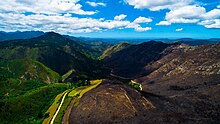
当所谓火三角的所有必要元素都集中在一个易受影响的区域时,就有发生野火的机会:点火源与可燃材料(例如植物)接触,材料受到足够的热量,并从周围获得充足的氧气。当水分含量高的时候,通常会防止点燃,或是减缓传播,必须有足够的热度来把材料中的水分蒸发,并加热到燃点。[11][72]茂密的森林会提供更多树荫,产生较低的温度和较高的湿度,因此野火不易在此发生。[73]密度较小的材料如草和树叶,因为它们比密度较大的树枝和树干含有较少的水分,较易点燃。 [74]植物经蒸发散会持续失去水分,但通常可从土壤、湿气或雨水中吸收水分而达到平衡。[75]如果不能保持这种平衡,植物会变干,更易燃,这情况通常会在干旱时期发生。[76][77]
所谓野火前锋是火焰接触尚未燃烧的物质,造成接续燃烧的部分,或是闷烧的物质过渡到未闷烧的物质。[78]当前锋靠近时,火会透过对流和热辐射而加热周围的空气和木质。首先,当水被100°C (212°F) 的温度蒸发时,木材变干燥。木材接着在230°C (450°F) 时开始热裂解,释放出易燃气体。最后木材会在380°C (720 °F) 下闷烧,或经充分加热后,在590°C (1,000°F) 下点燃。[79][80]在野火火焰到达特定位置之前,野火前锋的热传播就会把空气加热到800°C(1,470°F),为易燃材料预热以及干燥,而让材料更快着火,并让火势蔓延更快。[74][81]高温和长时间的地表野火会助长闪燃(也称torching):烘干林冠,随后让下方开始着火。[82]
野火通过稠密,不间断的易燃材料燃烧时,具有快速的前向传播率 (forward rate of spread ,FROS)。[83]其移动速度可达每小时10.8公里(6.7英里/小时),在草原上的移动速度可达每小时22公里(14英里/小时)。[84]野火会往与主前锋呈切线的方向发展,形成侧锋,或是回锋,朝主锋的相反方向燃烧。[85]它们还可通过余烬跳跃传播,因为风和垂直对流柱携带火种(木材余烬)和其他燃烧材料穿越原本可充当防火道的道路、河流和其他障碍物。[86][87]树冠上的闪燃和火灾助长跳跃点燃,野火周围干燥的地面燃料特别容易点燃。[88]当炽热的余烬和火种顺风跳跃点燃远处的燃料时,会造成局部火灾。在澳大利亚发生的丛林大火,已知最远的余烬跳跃是发生在野火前锋之前20公里(12英里)处。[89]
北美洲在近年发生不受控制的大型野火次数有所增加,对城市和农业集中区产生重大影响。不受控制的火灾造成的身体伤害和健康压力尤其会摧毁受灾区的农场和牧场经营者,引起医疗保健提供者群体的关注,并倡导为这一群组提供服务。[90]
特别是大型野火会以其烟囱效应影响到附近的气流:空气受热后上升,大型野火会产生强大的上升气流,从周围区域吸入新的、较冷的空气而形成热柱。[91]这种具有不同温度和湿度的巨大垂直气流形成具有龙卷风威力的火积云、强风和火龙卷,速度超过每小时80公里(50英里/小时)[92][93][94]快速传播速度、大量的冠火或是跳跃点燃、火龙卷出现和强烈生成对流柱,显示已创造出极端条件。 [95]
野火产生的热量会导致岩石和巨石严重风化。这种热度可让巨石迅速膨胀并发生热冲击,造成结构破坏。
气候变化影响
[编辑]

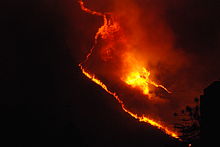
热浪和干旱提升风险
[编辑]热浪、干旱、气候变化(如厄尔尼诺现象)和区域天气模式(如高压脊)会增加风险,并显著改变野火的行为。[97][98][99]降水多年后,接着有温暖的时期,会助长更广泛的火灾和更长的火灾季节。[100]热浪以同样的方式影响野火,让草木变干,更易燃。[101]自20世纪80年代中期以来,较早的融雪和相关变暖也与美国西部野火季节(即一年中最易发生火灾的时间)[102]的长度和严重程度的增加有关联。[103]全球变暖会促进许多地区干旱的强度和频率,造成更强烈和更频繁的野火。[8]在2019年所做的一项研究显示,加利福尼亚州火灾风险的增加或可归因于人类活动导致的气候变化。[104]一项对8,000多年前冲积层沉积物的研究发现,较温暖的气候时期曾发生严重的干旱和林木更换火灾,并总结出气候对野火的影响如此强大,以至于在较温暖的未来,想要重建经历开发之前之的森林结构,几乎不可能。[105]
野火强度也会在白天增加。由于湿度较低、温度升高和风速增加,原木在白天的闷烧率可提高达五倍。[106]白天的阳光让地面变暖,产生向上移动的气流。到晚上,土地变冷,产生下降的气流。野火受到这类气流煽动,经常会随之越过山丘和谷地。[107]欧洲的野火经常发生在中午12点和下午2点。[108]美国的24小时森林消防行动从上午10点展开,因为白天的温度会让当时的强度增加。[109]
1974年至1975年的夏天,位于南半球的澳大利亚遭受有记录以来最严重的野火,该国有15%的陆地遭受“大面积火灾破坏”。[110]那年的大火烧焦大约1.17亿公顷(2.9亿英亩;1,170,000平方公里;450,000平方英里)的土地。[111][112]澳大利亚自1950年以来,许多地区每年的炎热天数(35°C以上)和酷热天数(40°C以上)显著增加。该国一直有丛林大火发生,但在2019年的火灾范围和凶猛程度急剧增加。[113]大雪梨地区在当年首次宣布发生灾难性丛林大火。新南威尔士州和昆士兰州宣布进入紧急状态,而南澳州和西澳州也有野火发生。[114]
2019年,极端高温和干燥的气候(参见2019年的气候变化)在西伯利亚、美国阿拉斯加州、西班牙加纳利群岛、澳大利亚和亚马逊雨林引发大规模野火。在亚马逊雨林的火灾主要是由非法伐木所引起。火灾产生的烟雾在广大地区蔓延(包括几个主要城市),而大幅降低空气质量。[115]
截至2020年8月,当时野火的严重程度比2019年高出13%,主因是气候变化和森林砍伐。[116]亚马逊雨林的生存受到野火的威胁。[117][118][119][120]根据英国世界自然基金会科学与保护执行主任迈克·巴雷特 (Mike Barrett) 的说法,如果这片热带雨林被毁,“人类将输掉应对气候变化的斗争。永无回头路可走。”[116]在2021年,土耳其、希腊、美国加利福尼亚州和俄罗斯均发生破纪录的野火,被认为均与气候变化有关联。[121]
火灾产生的二氧化碳和其他排放物
[编辑]野火释放大量二氧化碳、黑碳和褐碳微粒,以及臭氧前体物,如挥发性有机物和氮氧化物 (NOx)。 [122][123]这些排放会影响区域性乃至全球的太阳辐射、云层和气候。野火还会释放大量的半挥发性有机物,这些物质可在排放后数小时至数天内从气相中分离出,形成二次有机气溶胶 (SOA)。此外,在空气传输过程中形成的其他污染物会让远离野火区的人群接触到有害物质。[124]野火直接排放的污染物会影响第一线救灾人员和当地居民,但烟雾也会以长距离传输方式,影响到当地、区域性和全球空气质量。[125]输送的烟雾是否与地表空气质量相关,取决于它们在大气中的位置,而这又取决于烟雾初始进入大气的高度。喷射到大气边界层 (PBL) 上方的烟雾可从气象卫星检测到,并在改变地球能量收支方面发挥作用,但不会与地表空气混合,而影响到空气质量和人类健康。而困在大气边界层浅层中的烟雾(透过夜间稳定的大气分层或是地形捕获)会因特别集中,而对地表空气质量造成问题。在整个火灾生命周期中,野火强度和烟雾排放量并不恒定,会倾向遵循在下午晚些时候和傍晚达到峰值的昼夜循环模式,与数理的单峰或双峰正态分布相当近似。[126]
在过去一个世纪,野火占全球碳排放量的20-25%,其余来自人类活动。 [127]到2020年8月,全球野火造成的碳排放量相当于欧盟的年平均排放量。[116]加利福尼亚州在2020年,野火释放的碳明显高于该州其他来源的碳排放量。[128]
生态学
[编辑]
野火在整个陆地生命史中均有,引发的猜想是火一定对大多数生态系统的动植物产生显著的进化影响。[6]野火在有足够湿度可让植被生长,但又有延长的干燥及炎热时期的气候中很常发生。[129]这些地方包括澳大利亚和东南亚的植被区、南非草原、南非西开普省的弗因博斯(灌木丛)、美国和加拿大的森林地区以及地中海盆地。
严重的野火创造出复杂的早期迁移森林(也称为“断枝森林”),其中物种丰富度和多样性通常高于未经燃烧过的原始森林。[16]大多数的北美森林中的植物和动物都是随着火灾进化而来,其中许多物种依靠野火(尤其是严重型的)来繁殖和生长。火有助于将植物中的养分土壤送返,火的热量对于某些类型的种子发芽有其必要,而由高度烈火造成的断枝(枯树)和早期演替的森林创造出对野生动物有益的栖地条件。[16]由高强度火灾产生的早期演替森林中的温带针叶林,存有最高水平的生物多样性。[17][130]火后伐木并无生态效益,而有很多负面影响;火后播种通常也是如此。[131]
一些生态系统依靠自然发生的火灾来调节生长,但也有些生态系统遭受过多的火灾,例如南加利福尼亚州的浓密常绿阔叶灌丛和美国西南部的低海拔沙漠。火灾在这些通常依赖火灾的地区,频率的增加把自然循环扰乱,破坏本地植物群落,并促进非本地杂草的生长。[132][133][134][135] 入侵物种如小叶金沙和绢雀麦可在受火灾破坏的地区迅速生长。因为它们高度易燃,会增加未来发生火灾的风险,形成一个正反馈回路 - 增加火灾频率并进一步改变原生植被群落。[68][136]
在亚马逊雨林,干旱、伐木、养牛和刀耕火种农业把耐火森林破坏,并促进易燃灌木丛生长,形成一个促进更多野火的循环。[137]热带雨林中的火灾威胁到其中存在的各类物种,并排放大量的二氧化碳。[138]预计到2030年,热带雨林中的火灾,伴随着干旱和人类参与,可能会破坏或摧毁一半以上的亚马逊热带雨林。[139]野火产生灰烬,把有机养分的来源降低,并导致径流增加,冲走其他养分,并让暴洪频繁发生。.[62][140]一场在2003年发生于北约克沼泽国家公园的野火,烧毁面积2.5平方公里(600英亩)的杜鹃花丛和地下的泥炭层。之后的风蚀把灰烬剥离,土壤裸露,而让可追溯到公元前10,000年的考古遗迹被发现。[141]野火也会对气候变化产生影响,增加释放到大气中的碳量并抑制植被生长,而影响植物对碳的整体吸收。[142]
在苔原上,燃料和野火的积累有一种自然模式,这种模式因植被和地形的性质而异。在阿拉斯加州所做的研究显示,火灾事件重现间隔 (FRI) 通常在150到200年的范围内变化,在干燥的低地发生的野火频率较潮湿的高地为高。 [143]
植物适应
[编辑]
植物在容易发生野火的生态系统中,通常会适应当地的火情以利生存。这种适应包括对抗热的物理保护、火灾事件后增快的生长以及长出易燃材料,既能助长火灾,并可消除竞争。例如桉树类含有助燃的油脂和坚硬的硬质树叶,可抵抗高温和干旱,确保它们比耐火性较差的物种具有存活优势。[144][145]致密的树皮、会脱落的低树枝和外部结构中的高含水量也可保护树木免受温度升高的影响。[129]耐火种子和火灾后会长出的备用幼芽,促进物种有如先锋物种般,提高存活的机会。烟雾、烧焦的木料和热量可刺激种子发芽,这个过程称为延迟发芽。 [146]暴露于野火产生的烟雾中会诱导橙色丁烯内酯产生,而促进其他植物发芽。[147]
在沙巴西部草原中马来西亚的松树林和印尼的木麻黄森林被认为是前几期发生野火后的结果。[148]名为Chamise的枯木残枝含水量低且易燃,这类灌木在野火后可迅速发芽。[148]开普敦百合花处于休眠状态,直到火焰烧掉覆盖物后,这种植物几乎可在一夜之间完成开花。 [149]红杉依靠周期性的野火来减少竞争、从球果中释放种子,并清理土壤和树冠以促进新树的生长。[150]巴哈马松园中的加勒比松已适应并依赖低强度地表火灾来生存和生长。最佳火灾频率是每3到10年发生一次。过于频繁的野火对草本植物有利,而不频繁的火灾有利于巴哈马干燥森林类型的树木。[151]
大气效应
[编辑]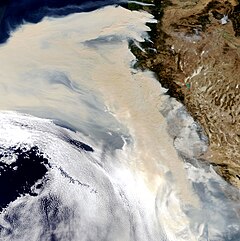
地球上的天气和空气污染大部分都存在对流层,这是个从地球表面延伸至约10公里(6英里)高的大气层。在大型野火地区,强烈雷暴(或称积雨火积云)的垂直升力会增强,把烟雾、煤烟和其他悬浮微粒推到平流层下部。 [152]从前流行的科学理论认为平流层中的大部分微粒来自火山,但从平流层下部却可检测到烟雾和其他野火排放物。[153]火积云可达到野火上方6,100米(20,000英尺)的高度。[154]在超过1,600公里(1,000英里)的上方可利用感测卫星对野火烟雾做完整的追踪。[155]可使用大气扩散模型(如CALPUFF电脑辅助模型)来帮助预测野火产生的烟雾的大小和方向。[156]
野火会对当地的大气污染程度产生影响,[157] and release carbon in the form of carbon dioxide.[158]并以二氧化碳的形式释放碳。[158]野火排放物含有微细颗粒物,对曝露者造成心血管和呼吸系统问题。[159]对流层中增加的火灾副产物会让臭氧浓度超过安全水平。[160]估计印尼在1997年的森林大火向大气中释放8.1至25.7亿公吨(8.9至28.3亿短吨)的二氧化碳,占全球每年燃烧化石燃料产生二氧化碳的13%至40%。[161][162]根据欧洲中期天气预报中心哥白尼气候变化服务的分析,2019年6月和7月在北极发生的野火排放超过1.4亿吨的二氧化碳。这数量相当于3,600万辆汽车在一年内排放的碳量。最近的野火及其大量的二氧化碳排放显示,在实施符合巴黎气候协定的温室气体减排目标措施时,把野火因素列入考虑非常重要。[163]由于野火烟雾在大气的传输过程中会发生复杂的氧化化学反应,[164]表明排放物的毒性会随着时间而增加。[165][166]
执行大气模型模拟,显示这些烟尘微粒的浓度会让冬季月份对太阳辐照的吸收增加多达15%。[167]估计亚马逊盆地约拥有900亿吨碳。截至2019年,地球大气层的碳含量为百万分之415,而破坏亚马逊盆地会让二氧化碳浓度增加约百万分之38。[168]
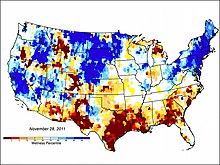
预防
[编辑]野火预防指的是降低火灾风险并减轻其严重程度和蔓延的先发制做法。[169]采用的目的是为管理空气质量、维持生态平衡、保护资源,[136]并达到控制未来野火的目的。[170]北美的消防政策是容许自然引起的火灾,以维持其生态作用,只需把窜入高价区域的风险降低即可。[171]但预防政策必须把人类在野火中扮演的角色列入考虑,因为例如欧洲的森林火灾中有95%都与人类涉入有关。 [172]人为火灾的来源包括人为纵火、意外着火或在开垦土地和农业(如东南亚的刀耕火种)时不受控制用火的缘故。[173]
美国总统富兰克林·罗斯福在1937年发起一场全国性的防火运动,强调人类粗心大意在森林火灾中的作用。运动在后来的海报以山姆大叔、华特迪士尼影片小鹿斑比中角色和美国国家森林局的官方吉祥物斯莫基熊作为特色代表。[174]减少人为引起的点火是减少不必要野火的最有效方法。
世界各地的野火预防计划会采用如野地用火(wildland fire use,WFU) 和策略烧除技术。[175][176]野地用火是指受监控但容许燃烧的任何自然原因的火灾。策略烧除是政府机构在不太危险的天气条件下点燃的火灾。 [177]根据美国鱼类及野生动物管理局的说法,在人们不会受到威胁的崎岖、陡峭或极难进入的地形里,野地用火可免除消防员面临不合理的风险。而能同时达到其他目标,包括维护健康的森林、牧场和湿地,以及支持生态系统多样性。[178]
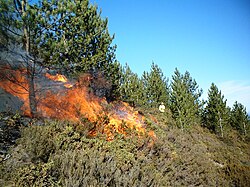
历经多年,在预防、检测、控制和抑制野火的策略已发生改变。[179]策略烧除是种常见且廉价,可降低不受控制野火风险的技术:利用故意点燃较小强度的火,把易燃材料的数量先行尽量减少,可降低潜在野火发生。[180][181]可定期燃烧植被,以限制植物和其他可用作燃料的残余物积累,又能同时保持高度的物种多样性。 [182][183]已故前美国地质调查局科学家Jan Van Wagtendonk声称,野火本身是“降低火灾蔓延速度、火线强度、火焰长度和单位面积热量的最有效处理方法。”[184]虽然有人声称控制燃烧和容许一些野火燃烧的政策是最便宜的方法,并对许多森林来说是生态上合适的政策,但他们往往并未考虑到被火灾烧掉资源的经济价值,尤其是可供销售的木材。[131]一些研究的结论是,虽然伐木也可把燃料移除,但在极端天气时,这种疏伐处理可能无法有效降低火灾的严重程度。[185]
但美国农业部、美国国家森林局太平洋西北研究站以及蒙大拿大学的林业学院和商业与经济研究局等机构进行的研究,通过对火灾危害的战略评估和不同减灾措施的潜在效果和成本,清楚显示最有效的短期和长期森林火灾减灾战略,以及迄今为止实现长期森林火灾风险缓解,最具成本效益的方法是综合燃料减少策略,包括利用商业伐木和非商业间伐,利用机械化手段移除积压的树木,对被移除的树木的大小不设限制。此与非商业的“下方疏伐”操作,或是有树木直径限制的商业伐木作业相比,会有较好的长期效果。从具有火灾“高风险”且处理前树冠指数为21的森林开始,仅移除非常小的树木的“下方疏伐”做法,导致树冠指数立即达到43,处理后区域中的29%立即被评为“低风险”,而30年后只有20%的处理过区域维持“低风险”的评等,处理每英亩的成本(净经济损失)为439美元。而同样从具有火灾“高风险”且处理前树冠指数为21的森林开始,采用非商业性间伐和商业采伐(采用树木直径限制),导致树冠指数立即达到43,处理后区域中的67%立即被评为“低风险”,56%经处理过的区域在30年后仍保持低风险,处理每英亩成本为368美元。而另一方面,从具有火灾“高风险”且处理前树冠指数为21的森林开始,综合火灾危害减少处理策略,不限制移除树木的大小,导致树冠指数立即达到61,处理后区域中的69%立即被评为“低风险”,52%经处理过的区域在30年后仍保持“低风险”,处理每英亩收益(净经济收益)为8美元。[186][187]
易发生野火区域的建筑规范通常要求使用耐火材料,并利用在建物四周规定的距离内清除易燃材料来设置防火空间。[188][189]菲律宾的社区还在森林和居民村庄之间建构5至10米(16至33英尺)宽的防火道,并在夏季或干旱的季节安排人员在防火道巡逻。[190]在火灾多发地区持续进行住宅开发和重建被火灾毁坏的建筑的举动受到批评。[191]野火能产生的生态效益往往比不上保护建筑物和人类生命的经济和安全利益。[192]
侦测
[编辑]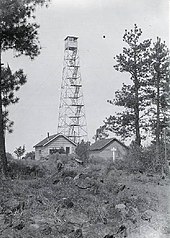
快速加上有效的侦测是扑灭野火的关键因素。[193]早期的工作重点是及早响应、日或夜间均可得到准确的资讯,以及确定处理的优先级。[194]20世纪初,美国采用的是火警瞭望塔,并使用电话、信鸽和日光反射仪传达信息。[195]在1950年代开始使用即时成像相机进行空中和陆地摄影,到1960年代开发出可侦测火灾的红外摄影。但因为受到通信技术的限制,信息的传递及分析常会延迟。早期经由卫星所得资料的分析是在距离遥远的站点,在地图上以手绘方式标示,再利用快件寄送到应变中心。在1988年黄石公园大火期间,当局在蒙大拿州西黄石建立一个据站,让从卫星传来的火灾信息可在大约4小时内送达应变中心。[194]
目前的情况时是可利用公共热线、火警瞭望塔以及地面和空中巡逻作为早期发现的手段。但依赖人观察,会受到作业人员疲惫、一天中特定的时间、一年中特定的时间和地理位置的限制。近年来,利用电子系统作为克服人为错误的做法受到欢迎。这类系统依据地区风险和是否有人在当地活动而设定为半自动或是全自动的运作。可把卫星数据、航空图像和人员位置,配合全球定位系统 (GPS) 把多个资料来源整合为一整体,供灾难指挥中心以近乎实时作业方式进行救灾行动。[196]
对于植被茂密、人烟稠密或靠近关键城区的小型高风险区域,可安装无线感测网络进行监测。这类系统也包含自动天气侦测的功能:检测温度、湿度和烟雾。[197][198][199][200]可采电池供电、太阳能供电或是利用树木充电(使用植物中的小电流为电池充电)。[201]对面积较大的中等风险区域可利用扫描塔进行监控,扫描塔装有固定摄像头和传感器,可检测烟雾或其他因素,例如火灾产生的二氧化碳的红外信号。其他功能,例如夜视、亮度检测和颜色变化检测,也可并入功能之中。[202][203][204]

通过飞机、直升机或无人机以及人造卫星进行空中监测可提供更广阔的视野,足以监测面积非常大而风险较低的区域。这些复杂的系统采用GPS和机载红外线或是高分辨率摄影机来识别和找出野火。[205][206]卫星上安装的传感器,例如欧洲环境卫星(Envisat)上的AATSR和欧洲遥感卫星的沿轨扫描辐射计,可侦测火灾发出的红外线辐射,找出温度高于39°C(102°F)的热点。[207][208]美国国家海洋暨大气总署的灾害测绘系统(Hazard Mapping System)把来自静止环境観测卫星 (GOES)、中分辨率成像分光辐射计 (MODIS) 和高级超高分辨率辐射计 (AVHRR) 等卫星的遥感数据整合,用于侦测火灾和烟雾位置。[209][210]但卫星侦测容易出现偏移误差,MODIS和AVHRR数据的偏移误差为2至3公里(1至2英里),GOES数据的偏移误差高达12公里(7.5英里)。[211]地球静止轨道上的卫星可能会失效,而绕极轨道卫星通常会受到观测时间窗口较短的限制。云量和图像分辨率也可能对卫星图像造成限制。[212]全球在线森林监视系统全球森林观察提供每日更新的详细火灾警报,资料来源为美国国家航空航天局(NASA)。[213]
美国农业部和美国国家森林局在2015年启用一种新的火灾侦测工具,此工具使用来自索米国家极地轨道伙伴卫星(Suomi NPP ) 的数据,比以前的太空侦测装置能更详细侦测到较小的火灾。所得到的高分辨率影像与电脑模型一起使用,可预测火灾在不同的天气和土地条件下的方向变动。使用来自Suomi NPP的可见红外成像辐射计套件 (VIIRS) 的主动火灾探测产品数据,将火灾观测的分辨率提高到可显示小至1,230英尺(375米)的影像。而2000年代初期的先前NASA卫星数据产品数据的分辨率仅能显示3,280英尺(1公里)影像。[214]此数据是美国国家森林局和美国内政部机构用来引导资源分配和火灾战略管理的工具之一。增强型VIIRS能每12小时或更短时间内侦测到更小型的野火,并在长期野火期间提供更详细和一致的火线跟踪,这些功能对于早期预警系统和支援火灾进度常规绘图非常重要。通过美国国家森林局遥感应用中心的数据处理,用户可在卫星通过几分钟内获得活跃的火灾位置。科罗拉多州决定从2016年火灾季节开始采用这套火灾模型用于对抗野火的作业。
近年来,对及时、高质量火灾信息的需求不断增加。美国的野火每年平均烧毁700万英亩土地。美国森林管理局和内政部在过去10年内每年平均花在扑灭野火的经费约为20-40亿美元。
扑灭
[编辑]
野火扑灭取决于发生野火的地区可用到的技术。在未开发国家,所采用的技术可能只有简单的如洒沙,或是用棍子或棕榈叶来灭火的做法。[215]在更先进的国家,抑制方法因技术能力的提高而会有所不同。碘化银可用于促进降水,[216]而阻燃剂和水可透过无人机、固定翼飞机和直升机投入火中。[217][218]救火者不再期望将野火完全扑灭,但大多数野火会在失控之前就被扑灭。每年发生的10,000起新的野火中有99%以上会受到控制,在极端天气下的野火,除非是天气发生变化,否则很难控制。加拿大和美国的野火平均每年会在54,500平方公里(13,000,000英亩)的土地上肆虐。[219][220]
最重要的是扑灭野火可能会导致消防员丧命。野火的燃烧锋面也可能会意外改变方向并跳过防火道。现场的酷热和烟雾会导致消防队员迷失方向和无法辨识火的走向,这种情况特别危险。例如在1949年,美国蒙大拿州曼恩峡谷大火期间,13名空降消防员因通讯失联、迷失方向,而被大火吞噬。[221]在2009年2月的维多利亚森林大火中,至少有173人死亡,超过2,029所房屋和3,500座建筑物陷入火海。[222]
扑灭野火成本
[编辑]扑灭野火的成本要花掉一个国家国内生产毛额(GDP)的很大部分,会直接影响到国家经济。[223]每年的灭火成本因每个火灾季节的严重程度而有差别,但在美国,地方、州、联邦和原住民部落机构每年共花费巨大金额来做这类的工作。据报导,美国在2004年至2008年间已花费大约60亿美元来扑灭野火。 [223]美国森林局在加利福尼亚州每年花费约2亿美元来扑灭98%的野火,并花费高达10亿美元来扑灭其他的2%,这类野火是最初的行动未能完全扑灭,而成为大规模的。[224]
野地救火安全
[编辑]
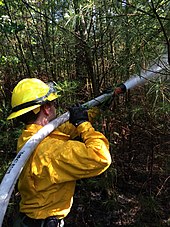
在野地执行灭火的消防员面临多种危及生命的风险,包括高热、疲惫、烟雾和灰尘,以及其他的伤害,如灼伤、割伤和挫伤、动物咬伤,甚至有横纹肌溶解症。[225][226]在2000年至2016年间,美国有超过350名野地消防员殉职。[227]
特别是在炎热的天气下,火灾会带来高热的风险,导致发热、疲惫、虚弱、眩晕、头痛或恶心。高热会发展为热应变,会导致心率和核心温度升高等生理变化,而造成与热有关的疾病,例如热疹、痉挛及中暑。各种因素都会引发高热带来的风险,包括繁重的工作、年龄和体适能等个人风险因素、脱水、睡眠不足以及沉重的个人防护装备。休息、凉水和偶尔休息对于减轻高热的影响甚为重要。 [225]
烟雾、灰烬和残余物也会对野地消防员造成严重的呼吸系统危害。野火产生的烟雾和灰尘含有一氧化碳、二氧化硫和甲醛等气体,以及灰烬和二氧化硅等微粒。为减少烟雾暴露,消防员应尽可能让消防员轮流穿过浓烟区,避免于下风处作业,在控制区域尽量以机器取代人力,在浓烟区尽量减少大口吸气。营地和指挥所也应设于野火的上风处。防护服和装备也能最大程度减少消防员对烟雾和灰烬的接触。[225]
消防员也有发生心血管状况的风险,包括中风和心脏病发作。消防员应保持良好的身体状况。包括压力测试在内的健身计划、医学筛检和检查可最大限度把紧急心脏问题的风险降低。[225]野地消防员可能会碰到的其他伤害风险包括滑倒、绊倒、跌倒、灼伤、挫伤和被工具和设备割伤、受到树木、车辆或其他物体撞击、植物危害(如荆棘和毒藤)、蛇和动物咬伤、车祸、电力线或闪电风暴导致的触电以及不稳建筑坍塌的风险。[225]
消防员安全区指南
[编辑]美国森林局发布一项消防员应与火焰保持最小距离的指南。[228]国家野火协调小组刊行的事件响应袖珍指南[229]说:“安全区指的是消防员在没有防火遮蔽的情况,仍能存活的区域”并且应该“......至少是最大连续火焰高度的4倍。”[230]但此数字只考虑辐射热的影响,没把地形和风的因素考虑在内。
安全区可以是自然环境,例如碎石堆、草地和河坝;或人为环境,例如停车场或已利用机械把植被清除的区域。
阻燃剂
[编辑]阻燃剂可抑制燃烧,而减缓野火发展。阻燃剂是磷酸铵和硫酸铵,以及增稠剂的水溶液。[231]使用阻燃剂的场合取决于野火的规模、位置和强度。在某些情况下,阻燃剂可用作预防用途。[232]
典型的阻燃剂含有与肥料相同的成分,可能经溶淋、优氧化或错误施用而影响水质。但阻燃剂对饮用水的影响尚无定论。[233]包括水体大小、降雨量和水流率等稀释因素会降低阻燃剂的浓度和效力。[232]野火残余(灰烬和沉积物)会堵塞河流和水库,增加洪水和侵蚀的风险,最终会降低和/或破坏水处理系统的功能。[233][234]人们一直担心阻燃剂对土地、水、野生动物栖息地和流域品质的影响,因此需要进行更多研究。但从积极面来看,阻燃剂(特别是其氮和磷成分)已被证明对养分匮乏的土壤具有增加肥力作用,会在短期内增加植被生长。[232]
美国农业部目前的作业流程坚持,实施空中喷洒空阻燃剂必须离开水道至少300英尺,以避免阻燃剂被径流携带进入。空中喷洒阻燃剂要避开在水道和濒危物种(植物和动物)栖息地附近使用。美国森林局要求当发生阻燃剂误用事件后,必须报告,并针对影响做评估,以确定对该地区是否须实施缓解、补救措施,和/或未来的使用限制。
建模
[编辑]

野火建模是针对野火做电脑模拟,以明了和预测火灾行为。[235][236]建模的目的在帮助抑制野火,提高消防员和公众的安全,并能最大限度减少损失。这种建模是运用运算科学,对过去火灾事件的统计分析,以预测跳跃点燃的风险和野火前锋的行为。但野火前锋的确切行为取决于多种因素,包括风速和坡度。现代野火增长模型结合过去的椭圆体描述和惠更斯-菲涅耳原理,把火势增长模拟为一个不断扩大的多边形。[237][238]极值理论也可用于预测大型野火的规模。但消防能力无法抑制的大火在标准分析中通常被视为统计学中的异常值,救火政策的拟定受大型野火的影响高于小型野火。[239]
风险和暴露
[编辑]野火风险是指野火在特定区域发生或蔓延到特定区域的可能性,以及如果发生会造成的财产损失程度。风险取决的变动因素,例如人类活动、天气模式、可供野火燃烧的材料多寡以及消防资源的有无。[240]野火一直对人类构成威胁。但人为引起的地理和气候变化让人们更频繁接触野火,以及增长野火风险。据推测,晚近野火增加的原因是因野火在过去一个世纪受到抑制,加上人类开发,迅速扩展到易生火灾野地的缘故。[241]野火是自然发生的事件,能促进森林健康。全球变暖和气候变化正导致美国的气温升高和更多干旱发生,导致野火风险增长。[242][243]
空气传播的危害
[编辑]野火造成最明显的影响是财产损失。但因燃烧而释放的有害化学物质也对人类健康产生重大影响。.[244]
野火烟雾主要由二氧化碳和水蒸气组成。其他常见,浓度较低的成分是一氧化碳、甲醛、丙烯醛、多环芳香烃和苯。[245]烟雾中也包含悬浮的固体或液滴形式的微细颗粒。在野火烟雾的微细颗粒中,有80-90%的直径为2.5微米或是更小。[246]
虽然在烟雾中的二氧化碳浓度很高,但由于其毒性低,因此对健康的危害较小。相反的,一氧化碳和微细颗粒物,尤其是直径为2.5微米(PM2.5)或更小的颗粒物已被确定为主要的健康威胁。[245]其他化学品被认为对健康有重大危害,但浓度太低而不会对健康造成可检测到的影响。
个人暴露于烟雾的程度取决于野火的严重性、持续时间和与距离。人们通过吸入空气污染物,而直接接触烟雾。社区暴露于野火产生的残余,其土壤和水受到污染,再间接影响到人类。
美国国家环境保护局 (EPA) 制定的空气质量指标 (AQI)是种公共资源,可为常见空气污染物提供国家空气质量标准。公众可使用此指数作为工具,根据能见度,确定他们接触有害污染物的程度。[247]
火灾生态学家Leda Kobziar发现野火烟雾在全球散布微生物。[248]她说,“我们在烟雾中发现多种过敏原。因此,一些对烟雾敏感的人可能具有这种敏感性,不仅是因为其颗粒物和烟雾的问题,还因为其中有些生物有机体。[249]
水污染
[编辑]野火过后,进入水道的残余物和化学物质会导致饮用水源不安全。野火会破坏水处理和输送基础设施,让饮用水不安全。建筑物内和输送系统中的饮用水可能受到化学污染。在2017年北加州的塔伯野火和2018年加州溪营大火之后,在受影响的多个公共饮用水系统中发现化学污染水平达到危险的程度。 [250]自2018年以来,野火破坏加利福尼亚州和俄勒冈州饮用水输送系统,造成污染。[251]野火过后,在饮用水系统中出现的众多化学物质中有苯。苯会渗透某些塑料管道,因此需要很长时间才能从供水基础设施中清除。研究人员使用EPA的模型模拟,[252]估计需要不间断持续冲洗受污染的管道超过286天,才能把饮用水中的苯降低到安全限度以内。 [253]由火灾(包括野火)引起的温度升高会导致塑料水管产生苯等有毒化学物质。[254] such as benzene.[255]
流入溪流和水库的沉积物会改变水的颜色和浊度,增加输送颗粒相关污染物的机会。饮用水中升高的沉积物浓度,让识别生物污染物变得更为困难,并且因含有大量养分而增加微生物的生长。
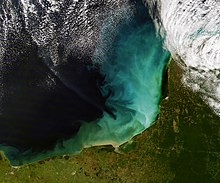
重要的是复合悬浮沉积物颗粒(而非初级颗粒),会在小粘性沉积物流经河流系统中占主导地位。微生物群落、有机和无机颗粒以及化学成分都包含在这些复合颗粒中,会对水质产生负面影响。燃烧过的聚集体比等直径的变态颗粒具有更大的下沉速度,归因于燃烧混合物密度的增加(有机物含量和孔隙同时减少)。此外,土壤经受热,由于粘土颗粒聚集成较粗的复合颗粒,相对于同等大小的初级颗粒,复合颗粒中的污染物浓度会更高。大量微细颗粒沉积物储存,和污染物从腐烂的聚集体延迟释放是燃烧效应对土壤颗粒的两个潜在影响。[256]
最近对火灾在生态系统的影响所进行的全球综合研究发现,森林火灾对水质有显著的负面作用。[257]
野火过后的风险
[编辑]野火过后,危险依然存在。返回家园的居民可能会因烧过的树木倒落而造成伤亡。人和宠物也可能因掉入灰坑而受伤害。联合国下属政府间气候变化专门委员会 (IPCC) 也报告说,野火会对电力系统造成重大破坏,尤其是在干旱地区。
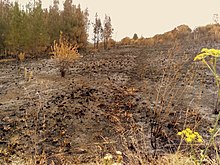
如果出现极端天气,灾后风险会增加。例如野火让土壤吸收降水的能力降低,强降雨会导致更严重的洪水和土石流。[258][259]
涉险群组
[编辑]消防员
[编辑]消防员因暴露在野火烟雾中,最大的风险是造成急性和慢性的健康影响。而消防员经常长时间及近距离接触危险化学品。一项关于野地消防员暴露于野火烟雾的案例研究,显示消防员暴露于显著水平的一氧化碳和呼吸道刺激物,高于美国职业安全卫生署(OSHA)设定的暴露限值 (PEL) 和美国政府工业卫生学家会议 (ACGIH)设定的阈值限值 (TLV)。过度曝露的占比有5–10%。根据研究,一名野地消防员在10小时轮班期间,会暴露在各种浓度的一氧化碳和呼吸道刺激物(3.5微米及更小的颗粒物、丙烯醛和甲醛组合)中。一氧化碳浓度高达160ppm(百万分比),TLV刺激指数值高达10。相较之下,OSHA一氧化碳的PEL为30ppm,对呼吸道刺激指数的TLV为1。[260]
2001年至2012年间,野地消防员死亡人数超过200人。除高温和化学危害外,消防员的风险还包括触电、设备伤害、滑倒、绊倒和跌倒、车辆翻车造成的伤害、与热有关的疾病、昆虫叮咬和蜇伤、压力和横纹肌溶解。[261]
居民
[编辑]
野火附近社区的居民接触到的化学物质浓度较低,较大的风险是因水或土壤污染而遭遇的间接曝露。这类暴露在很大程度上取决于个人的易感性。儿童(0-4 岁)、老人(65岁及以上)、吸烟者和孕妇等身体脆弱者,会面临更高的风险,即使暴露在低化学浓度和相对较短的时间也有伤害。[245]他们也面临着未来发生野火的风险,而必须迁移到他们认为风险较小的地区。 [262]
野火影响加拿大西部和美国的大量人口。仅在加利福尼亚州就有超过350,000人居住在“非常高火灾危险区域”内的城镇和都市。[263]
降低火灾易发地区风险的做法包括选择耐火植被、维护景观以避免碎屑堆积、建造防火道以及选择阻燃屋顶材料等。在较暖的月份,空气质量不良和热度的潜在复合问题可利用建筑物通风系统中的MERV11或更高的室外空气过滤系统、机械冷却,以及在需要时提供额外的空气清洁和冷却的避难区来应对。[264]
对健康影响
[编辑]
野火烟雾中含有对人体呼吸系统产生不利影响的颗粒物。应向公众宣导野火烟雾对健康影响的证据,促使避免接触。可用其影响健康的证据促成政策制定,以维护居民的健康。[265]
吸入野火产生的烟雾会危害健康。[266]这类烟雾由燃烧产物,即二氧化碳、一氧化碳、水蒸气、悬浮微粒、有机化学物、氮氧化物和其他化合物。主要的问题是吸入的颗粒物和一氧化碳。[267]
悬浮微粒 (PM) 是种由灰尘和液滴组成的空气污染物。根据颗粒的直径分为三类:粗、细和超微细。粗颗粒为2.5至10微米,细颗粒为0.1至2.5微米,超微细颗粒则小于0.1微米。每种尺寸都可经吸入而进入人体,但PM对人体的影响会因尺寸而异。粗颗粒在上呼吸道受到过滤,聚积后会引起肺部发炎。也会导致眼睛和鼻窦刺激以及喉咙痛和咳嗽。[268][269]粗颗粒通常由更重、毒性更大的材料组成,会导致强的短期效应。[269]
较小的颗粒会更进一步进入呼吸系统,在肺部深处和血液产生问题。[268][269]对于哮喘患者,PM2.5会引起发炎,也会增加上皮细胞的氧化应激。这些微粒还会引起肺上皮细胞的凋亡和自噬,这两过程都会导致细胞受损,功能受影响。对于那些已患有呼吸系统疾病(如哮喘)的患者而言会有严重的后果。[269]超微细颗粒 (UFP)可像PM2.5一样进入血液,但研究显示它进入血液的速度更快。UFP造成的发炎和上皮细胞损伤也更为严重。[269]PM2.5是与野火有关问题中最重大者。[265]这对年幼者、老年人以及患有哮喘、慢性阻塞性肺病 (COPD)、囊性纤维化和心血管疾病等慢性疾病的人尤其危险。接触烟雾中的颗粒物后最常见的疾病是支气管炎、哮喘或慢性阻塞性肺病恶化以及肺炎。这些并发症的症状有喘息、呼吸急促和心血管症状(包括胸痛、心率加快和疲惫)。[268]
哮喘加剧
[编辑]野火产生的烟雾对尤其是对儿童和已经有呼吸系统疾病的人而言,有严重的后果。[270]几项流行病学研究显示,空气污染与支气管哮喘等呼吸道过敏性疾病之间有密切关联。[265]
一项针对2007年美国圣地亚哥野火烟雾暴露的观察性研究显示,医疗保健利用率和呼吸系统诊断都有所增加,尤其是抽样组中的哮喘患者。[270]对发生野火的气候预测情景中,幼儿呼吸系统疾病会显著增加。[270]PM会触发一系列生物过程,包括发炎免疫反应、氧化应激,这些过程与过敏性呼吸系统疾病的变化有关联。[271]
虽然有些研究显示与PM相关的哮喘患者肺功能并无显著的急性变化,但对这类违反直觉的发现,可能的解释是患者为应对烟雾浓度升高,而增加快速缓解药物(如吸入剂)使用的结果。[272]在调查阻塞性肺病的药物使用与野火暴露之间的关联时,研究人员发现使用吸入剂和长期控制药物(如口服类固醇)的案例都有增加。[272]更具体地说,一些哮喘患者报告他们会增加使用速效药物。[272]在加利福尼亚发生过两次重大野火后,研究人员发现在发生后的几年里,与每次发生的前一年相比,医生开出的速效药物处方都有所增加。[272]
野火烟雾与哮喘恶化之间存在一致的证据。[272]
致命暴露
[编辑]哮喘是美国儿童中最常见的慢性疾病之一,受到影响的儿童有620万人。[273]哮喘风险研究特别关注妊娠期遭遇空气污染的风险。这段期间涉及几个病理生理学过程。胎儿的呼吸道发育有相当大部分发生在第二和第三个三月期,持续到出生后的3年。[274]推测在此期间接触野火相关毒素,因为在此期间肺部上皮细胞对毒素有较高的渗透性,而产生相应的结果。在产前阶段暴露于空气污染,可能会诱发表观遗传学变化,而导致哮喘的发展。[275]虽然不同研究之间存有异质性,但研究发现PM2.5、二氧化氮与儿童时期哮喘发展之间存在显著关联。[276]此外,母亲暴露于慢性压力源最有可能在贫困社区发生,由于这可能与儿童哮喘相关,而进一步解释儿童早期暴露于空气污染、社区贫困和儿童风险之间的联系。同样的,贫困社区与污染源的位置和暴露有关,也与更大的慢性个人压力有关,母体免疫系统的压力负荷会被改变。反过来,儿童会因此出现不良后果,包括增加对空气污染的敏感性。[277]
一氧化碳的危害
[编辑]一氧化碳是种无色无味的气体,在闷烧火源的附近浓度最高。一氧化碳对野地消防员的健康构成严重威胁。一氧化碳经吸入肺部后,会进入血液,而减少血液携带氧气到身体重要器官的能力。高浓度的一氧化碳会导致头痛、虚弱、头晕、意识模糊、恶心、失去方向感、视力障碍、昏迷,甚至是死亡。即使在野火中的较低浓度,患有心血管疾病的人也会出现胸痛和心律失常。 [245]最近一项追踪1990年至2006年野地消防员死亡人数和原因的研究发现,心脏病发作死亡的比率有21.9%。[278]
野火对健康的另一重要,但不太明显的影响是精神疾病和失调。研究人员发现美国、加拿大、希腊和澳大利亚等国,经历过野火的成年人和儿童,他们表现出几种不同的精神状况,显示是直接和间接由野火影响的缘故。症状包括创伤后压力症候群 (PTSD)、抑郁、焦虑和恐惧症。[279][280][281][282][283]
流行病学
[编辑]在过去几十年里,美国西部的野火发生频率和强度都在增加。这一增长归因于美国西部的干燥气候和全球变暖的影响。据估计,从2004年到2009年,美国西部有4,600万人暴露在野火烟雾中。有证据显示野火烟雾会增加大气中的悬浮微粒含量。[265]
EPA已发布国家环境空气质量标准,为空气中可接受的悬浮微粒浓度设立标准,并强制监测环境空气质量。[284]由于这些监测计划,以及人口稠密地区附近发生的几起大型野火,随之的流行病学研究已证明人类健康影响与野火烟雾引起的微粒增加之间有关联。
国家环境空气质量标准是《美国清洁空气法案》中的一部分,为污染物水平和环境空气质量监测提供强制性指南。[284]除这类监测计划外,人口稠密地区附近野火发生率的增加也促成多项流行病学研究。此类研究显示,野火烟雾对人类健康的负面影响与悬浮微粒增加之间存在关联。颗粒物的大小很重要,因为较小的颗粒物很容易被吸入。而体积越小者会深入部肺组织,导致呼吸窘迫,以及疾病发生。 [265]
2002年6月科罗拉多州海曼大火排放的PM烟雾增加,与当地COPD患者呼吸道症状的增加有关。[285]采取类似的方式观察2003年10月南加州发生的野火,调查人员发现烟雾中PM的到达峰值浓度时,因哮喘发生而住院的人数有所增加。 [286]另一项流行病学研究发现,与相对非烟雾天气相比,在PM2.5浓度高的期间,呼吸道相关症状住院增加7.2%。[265]
参与儿童健康研究计划的儿童,其眼睛和呼吸道症状、药物使用和就诊次数也出现增加的情况。[287]最近有证据显示,在野火期间怀孕的母亲生下的婴儿,与未曾暴露过野火的母亲相比,平均出生体重略有下降。这显示孕妇也更容易受到野火的不利影响。[288]]据估计,全世界每年有339,000人因受野火烟雾影响而死亡。[289]
虽然颗粒物的尺寸是影响健康的重要因素,但还应考虑野火烟雾中PM2.5的化学成分。先前的研究显示野火烟雾中PM2.5的化学成分,与其他烟雾相比,可对人类健康结果产生不同的结果。[265]暴露于野火烟雾的人,其健康结果可能与暴露于固体燃料(如燃烧煤炭、木炭、木材及动物粪便)等烟雾来源的人不同。
文化层面
[编辑]野火在许多文化中都占有一席之地。 “To spread like wildfire(像野火般不胫而走)”是英语中的常用成语,意思是“迅速影响或被越来越多的人知道”的事物。[290]斯莫基熊(Smokey Bear)防火运动产生美国最受欢迎的角色之一,多年来一直有个神气活现的斯莫基雄吉祥物,甚至还发行邮票作纪念。[291]
参见
[编辑]- 干雷暴
- 适应火灾的社区
- 火灾生态学
- 混合单粒子拉格朗日积分轨迹模型(电脑软件模型,用以预测空气污染物扩散,化学转化和沉积)
- 世界知名野火列表
- 野火地理学
- 远程自动气象站
- 森林-城镇交界域
- 野火风险指数:
- 森林火灾气候指数 (加拿大,法国)
- 海恩斯指数
- 基持-拜阮干旱指数
- 麦克阿瑟森林火灾风险指数
- 美国国家火灾风险等级指数 (美国)
- 煤层火灾
参考文献
[编辑]- ^ Cambridge Advanced Learner's Dictionary Third. Cambridge University Press. 2008. ISBN 978-0-521-85804-5. (原始内容存档于2009-08-13).
- ^ CIFFC Canadian Wildland Fire Management Glossary (PDF). Canadian Interagency Forest Fire Centre. [2019-08-16]. (原始内容存档 (PDF)于2023-06-10).
- ^ Forest fire videos – See how fire started on Earth. BBC Earth. [2016-02-13]. (原始内容存档于2015-10-16).
- ^ Drought, Tree Mortality, and Wildfire in Forests Adapted to Frequent Fire (PDF). UC Berkeley College of Natural Resources. [2022-03-15]. (原始内容存档 (PDF)于2022-08-09).
- ^ Scott, Andrew C.; Glasspool, Ian J. The diversification of Paleozoic fire systems and fluctuations in atmospheric oxygen concentration. Proceedings of the National Academy of Sciences. 2006-07-18, 103 (29): 10861–10865. Bibcode:2006PNAS..10310861S. ISSN 0027-8424. PMC 1544139
 . PMID 16832054. doi:10.1073/pnas.0604090103
. PMID 16832054. doi:10.1073/pnas.0604090103  (英语).
(英语).
- ^ 6.0 6.1 Bowman, David M. J. S.; Balch, Jennifer K.; Artaxo, Paulo; Bond, William J.; Carlson, Jean M.; Cochrane, Mark A.; D’Antonio, Carla M.; DeFries, Ruth S.; Doyle, John C. Fire in the Earth System. Science. 2009-04-24, 324 (5926): 481–484. Bibcode:2009Sci...324..481B. ISSN 0036-8075. PMID 19390038. S2CID 22389421. doi:10.1126/science.1163886 (英语).
- ^ Bowman, David M. J. S.; Balch, Jennifer K.; Artaxo, Paulo; Bond, William J.; Carlson, Jean M.; Cochrane, Mark A.; D’Antonio, Carla M.; DeFries, Ruth S.; Doyle, John C. Fire in the Earth System. Science. 2009-04-24, 324 (5926): 481–484. Bibcode:2009Sci...324..481B. ISSN 0036-8075. PMID 19390038. S2CID 22389421. doi:10.1126/science.1163886 (英语).
- ^ 8.0 8.1 8.2 Flannigan, M.D.; B.D. Amiro; K.A. Logan; B.J. Stocks & B.M. Wotton. Forest Fires and Climate Change in the 21st century (PDF). Mitigation and Adaptation Strategies for Global Change. 2005, 11 (4): 847–859 [2009-06-26]. S2CID 2757472. doi:10.1007/s11027-005-9020-7. (原始内容 (PDF)存档于2009-03-25).
- ^ Graham, et al., 12, 36
- ^ National Wildfire Coordinating Group Communicator's Guide For Wildland Fire Management, 4–6.
- ^ 11.0 11.1 National Wildfire Coordinating Group Fireline Handbook, Appendix B: Fire Behavior (PDF). National Wildfire Coordinating Group. April 2006 [2008-12-11]. (原始内容存档 (PDF)于2008-12-17).
- ^ Trigo, Ricardo M.; Provenzale, Antonello; Llasat, Maria Carmen; AghaKouchak, Amir; Hardenberg, Jost von; Turco, Marco. On the key role of droughts in the dynamics of summer fires in Mediterranean Europe. Scientific Reports. 2017-03-06, 7 (1): 81. Bibcode:2017NatSR...7...81T. ISSN 2045-2322. PMC 5427854
 . PMID 28250442. doi:10.1038/s41598-017-00116-9 (英语).
. PMID 28250442. doi:10.1038/s41598-017-00116-9 (英语).
- ^ Westerling, A. L.; Hidalgo, H. G.; Cayan, D. R.; Swetnam, T. W. Warming and Earlier Spring Increase Western U.S. Forest Wildfire Activity. Science. 2006-08-18, 313 (5789): 940–943. Bibcode:2006Sci...313..940W. ISSN 0036-8075. PMID 16825536. doi:10.1126/science.1128834
 (英语).
(英语).
- ^ 14.0 14.1 14.2 14.3 14.4 Parmesan, Camille; Morecroft, Mike; Trisurat, Yongyut; et al. Chapter 2: Terrestrial and Freshwater Ecosystems and their Services (PDF). Climate Change 2022: Impacts, Adaptation and Vulnerability. Contribution of Working Group II to the Sixth Assessment Report of the Intergovernmental Panel on Climate Change. Intergovernmental Panel on Climate Change. [2023-05-31]. (原始内容 (PDF)存档于2022-02-28).
- ^ Heidari, Hadi; Arabi, Mazdak; Warziniack, Travis. Effects of Climate Change on Natural-Caused Fire Activity in Western U.S. National Forests. Atmosphere. August 2021, 12 (8): 981. Bibcode:2021Atmos..12..981H. doi:10.3390/atmos12080981
 (英语).
(英语).
- ^ 16.0 16.1 16.2 The Ecological Importance of Mixed-Severity Fires – ScienceDirect. www.sciencedirect.com. [2016-08-22]. (原始内容存档于2017-01-01).
- ^ 17.0 17.1 Hutto, Richard L. The Ecological Importance of Severe Wildfires: Some Like It Hot. Ecological Applications. 2008-12-01, 18 (8): 1827–1834 [2023-05-31]. ISSN 1939-5582. PMID 19263880. doi:10.1890/08-0895.1. (原始内容存档于2023-07-09) (英语).
- ^ Stephen J. Pyne. How Plants Use Fire (And Are Used By It). NOVA online. [2009-06-30]. (原始内容存档于2009-08-08).
- ^ Drought, Tree Mortality, and Wildfire in Forests Adapted to Frequent Fire (PDF). UC Berkeley College of Natural Resources. [2022-03-15]. (原始内容存档 (PDF)于2022-08-09).
- ^ Auer, Matthew R.; Hexamer, Benjamin E. Income and Insurability as Factors in Wildfire Risk. Forests. 2022-07-18, 13 (7): 1130. ISSN 1999-4907. doi:10.3390/f13071130
 (英语).
(英语).
- ^ Main Types of Disasters and Associated Trends. lao.ca.gov. Legislative Analyst's Office. 2019-01-10 [2023-05-31]. (原始内容存档于2023-06-03).
- ^ Machemer, Theresa. The Far-Reaching Consequences of Siberia's Climate-Change-Driven Wildfires. Smithsonian Magazine. 20207-09 [2023-05-31]. (原始内容存档于2023-06-05).
- ^ Australia, Government Geoscience. Bushfire. www.ga.gov.au. 2017-07-25 [2023-05-31]. (原始内容存档于2022-09-01).
- ^ Fires, Forests and the Future (PDF). World Wide Fund for Nature. 2020 [2022-10-31]. (原始内容存档 (PDF)于2023-10-10) (英语).
The area of land burned globally has actually been steadily declining since it started to be recorded in 1900
- ^ Wildfire Statistics. Congressional Research Service. 2022 [2022-10-19]. (原始内容存档于2023-08-16).
- ^ Earliest evidence of wildfire found in Wales – BBC News. [2023-05-31]. (原始内容存档于2023-06-01).
- ^ Glasspool, IJ; Edwards, D; Axe, L. Charcoal in the Silurian as evidence for the earliest wildfire. Geology. 2004, 32 (5): 381–383. Bibcode:2004Geo....32..381G. doi:10.1130/G20363.1.
- ^ Edwards, D.; Axe, L. Anatomical Evidence in the Detection of the Earliest Wildfires. PALAIOS. April 2004, 19 (2): 113–128. Bibcode:2004Palai..19..113E. ISSN 0883-1351. S2CID 129438858. doi:10.1669/0883-1351(2004)019<0113:AEITDO>2.0.CO;2.
- ^ Scott, C.; Glasspool, J. The diversification of Paleozoic fire systems and fluctuations in atmospheric oxygen concentration. Proceedings of the National Academy of Sciences of the United States of America. Jul 2006, 103 (29): 10861–10865. Bibcode:2006PNAS..10310861S. ISSN 0027-8424. PMC 1544139
 . PMID 16832054. doi:10.1073/pnas.0604090103
. PMID 16832054. doi:10.1073/pnas.0604090103  .
.
- ^ 30.0 30.1 Pausas and Keeley, 594
- ^ Historically, the Cenozoic has been divided up into the Quaternary and Tertiary sub-eras, as well as the Neogene and Paleogene periods. The 2009 version of the ICS time chart 互联网档案馆的存档,存档日期2009-12-29. recognizes a slightly extended Quaternary as well as the Paleogene and a truncated Neogene, the Tertiary having been demoted to informal status.
- ^ Pausas and Keeley, 595
- ^ Pausas and Keeley, 596
- ^ "Redwood Trees" 互联网档案馆的存档,存档日期2015-09-01..
- ^ Pausas and Keeley, 597
- ^ 36.0 36.1 Rackham, Oliver. Fire in the European Mediterranean: History. AridLands Newsletter. November–December 2003, 54 [2009-07-17]. (原始内容存档于2008-10-11).
- ^ 37.0 37.1 Rackham, 229–230
- ^ 38.0 38.1 Goldammer, Johann G. History of Fire in Land-Use Systems of the Baltic Region: Implications on the Use of Prescribed Fire in Forestry, Nature Conservation and Landscape Management. First Baltic Conference on Forest Fires. Radom-Katowice, Poland: Global Fire Monitoring Center (GFMC). 5–9 May 1998 [2018-12-09]. (原始内容存档于2009-08-16).
- ^ Pyne, Stephen J.; Williams, Gerald W. Wildland Fire - An American Legacy (PDF). Fire Management Today. Summer 2000, 60 (3) [2023-04-09]. (原始内容存档 (PDF)于2023-04-10).
- ^ Fire. The Australian Experience, 7.
- ^ Meyer, G.A.; Wells, S.G.; Jull, A.J.T. Fire and alluvial chronology in Yellowstone National Park: Climatic and intrinsic controls on Holocene geomorphic processes. GSA Bulletin. 1995, 107 (10): 1211–1230. Bibcode:1995GSAB..107.1211M. doi:10.1130/0016-7606(1995)107<1211:FAACIY>2.3.CO;2.
- ^ Pitkänen, et al., 15–16 and 27–30
- ^ J. R. Marlon; P. J. Bartlein; C. Carcaillet; D. G. Gavin; S. P. Harrison; P. E. Higuera; F. Joos; M. J. Power; I. C. Prentice. Climate and human influences on global biomass burning over the past two millennia. Nature Geoscience. 2008, 1 (10): 697–702. Bibcode:2008NatGe...1..697M. doi:10.1038/ngeo313. University of Oregon Summary, accessed 2010-02-02互联网档案馆的存档,存档日期2008-09-27.
- ^ Stephens, Scott L.; Martin, Robert E.; Clinton, Nicholas E. Prehistoric fire area and emissions from California's forests, woodlands, shrublands, and grasslands. Forest Ecology and Management. 2007, 251 (3): 205–216. doi:10.1016/j.foreco.2007.06.005.
- ^ Researchers Detect a Global Drop in Fires. NASA Earth Observatory. 2017-06-30 [2017-07-04]. (原始内容存档于2017-12-08).
- ^ Andela, N.; Morton, D.C.; et al. A human-driven decline in global burned area. Science. 2017-06-30, 356 (6345): 1356–1362. Bibcode:2017Sci...356.1356A. PMC 6047075
 . PMID 28663495. doi:10.1126/science.aal4108.
. PMID 28663495. doi:10.1126/science.aal4108.
- ^ Fires spark biodiversity criticism of Sweden's forest industry. phys.org. [2023-05-31]. (原始内容存档于2023-07-09).
- ^ The Great Lie: Monoculture Trees as Forests | News & Views | UNRISD. www.unrisd.org. [2023-05-31]. (原始内容存档于2021-08-06).
- ^ Plant flammability list (PDF). [2021-01-10]. (原始内容存档 (PDF)于2023-06-06).
- ^ Fire-prone plant list. [2018-08-09]. (原始内容存档于2018-08-09).
- ^ Wildfire Prevention Strategies (PDF). National Wildfire Coordinating Group: 17. March 1998 [2008-12-03]. (原始内容 (PDF)存档于2008-12-09).
- ^ Scott, A. The Pre-Quaternary history of fire. Palaeogeography, Palaeoclimatology, Palaeoecology. 2000, 164 (1–4): 281–329. Bibcode:2000PPP...164..281S. doi:10.1016/S0031-0182(00)00192-9.
- ^ Boxall, Bettina. Human-caused ignitions spark California's worst wildfires but get little state focus. San Diego Union-Tribune. 2020-01-05 [2020-11-25]. (原始内容存档于2023-06-19).
- ^ Wildfire, forest fire, grass fire, SpringerReference (Springer-Verlag), 2011, doi:10.1007/springerreference_29801
- ^ Liu, Zhihua; Yang, Jian; Chang, Yu; Weisberg, Peter J.; He, Hong S. Spatial patterns and drivers of fire occurrence and its future trend under climate change in a boreal forest of Northeast China. Global Change Biology. June 2012, 18 (6): 2041–2056. Bibcode:2012GCBio..18.2041L. ISSN 1354-1013. S2CID 26410408. doi:10.1111/j.1365-2486.2012.02649.x (英语).
- ^ de Rigo, Daniele; Libertà, Giorgio; Houston Durrant, Tracy; Artés Vivancos, Tomàs; San-Miguel-Ayanz, Jesús. Forest fire danger extremes in Europe under climate change: variability and uncertainty. Luxembourg: Publication Office of the European Union. 2017: 71. ISBN 978-92-79-77046-3. doi:10.2760/13180.
- ^ Krock, Lexi. The World on Fire. NOVA online – Public Broadcasting System (PBS). June 2002 [2009-07-17]. (原始内容存档于2009-10-27).
- ^ Balch, Jennifer K.; Bradley, Bethany A.; Abatzoglou, John T.; Nagy, R. Chelsea; Fusco, Emily J.; Mahood, Adam L. Human-started wildfires expand the fire niche across the United States. Proceedings of the National Academy of Sciences. 2017, 114 (11): 2946–2951. Bibcode:2017PNAS..114.2946B. ISSN 1091-6490. PMC 5358354
 . PMID 28242690. doi:10.1073/pnas.1617394114
. PMID 28242690. doi:10.1073/pnas.1617394114  (英语).
(英语).
- ^ Agricultural Fires Seem to Engulf Central Africa. NASA. 2020-06-26 [2021-06-21]. (原始内容存档于2022-11-19).
- ^ YouTube上的"Wildfires in Africa, 2021, April to December"
- ^ Krajick, Kevin. Fire in the hole. Smithsonian Magazine. May 2005 [2009-07-30]. (原始内容存档于2010-09-03).
- ^ 62.0 62.1 Graham, et al., iv.
- ^ Graham, et al., 9, 13
- ^ Rincon, Paul. Asian peat fires add to warming. British Broadcasting Corporation (BBC) News. 2005-03-09 [2008-12-09]. (原始内容存档于2008-12-19).
- ^ Hamers, Laurel. When bogs burn, the environment takes a hit. Science News. 2019-07-29 [2019-08-15]. (原始内容存档于2020-01-03) (英语).
- ^ Graham, et al ., iv, 10, 14
- ^ C., Scott, Andrew. Fire on earth : an introduction. Bowman, D. M. J. S.; Bond, William J.; Pyne, Stephen J.; Alexander, Martin E. Chichester, West Sussex. 2014. ISBN 978-1-119-95357-9. OCLC 854761793.
- ^ 68.0 68.1 Global Fire Initiative: Fire and Invasives. The Nature Conservancy. [2008-12-03]. (原始内容存档于2009-04-12).
- ^ Graham, et al., iv, 8, 11, 15.
- ^ Butler, Rhett. Global Commodities Boom Fuels New Assault on Amazon. Yale School of Forestry & Environmental Studies. 2008-06-19 [2009-07-09]. (原始内容存档于2009-04-11).
- ^ Bonta, Mark; Gosford, Robert; Eussen, Dick; Ferguson, Nathan; Loveless, Erana; Witwer, Maxwell. Intentional Fire-Spreading by "Firehawk" Raptors in Northern Australia. Journal of Ethnobiology. 2017, 37 (4): 700. S2CID 90806420. doi:10.2993/0278-0771-37.4.700.
- ^ The Science of Wildland fire. National Interagency Fire Center. [2008-11-21]. (原始内容存档于2008-11-05).
- ^ Graham, et al., 12.
- ^ 74.0 74.1 National Wildfire Coordinating Group Communicator's Guide For Wildland Fire Management, 3.
- ^ Ashes cover areas hit by Southern Calif. fires. NBC News. Associated Press. 2008-11-15 [2008-12-04]. (原始内容存档于2017-12-09).
- ^ Influence of Forest Structure on Wildfire Behavior and the Severity of Its Effects (PDF). US Forest Service. November 2003 [2008-11-19]. (原始内容存档 (PDF)于2008-12-17).
- ^ Prepare for a Wildfire. Federal Emergency Management Agency (FEMA). [2008-12-01]. (原始内容存档于2008-10-29).
- ^ Glossary of Wildland Fire Terminology, 74.
- ^ de Sousa Costa and Sandberg, 229–230.
- ^ Archimedes Death Ray: Idea Feasibility Testing. Massachusetts Institute of Technology (MIT). October 2005 [2009-02-01]. (原始内容存档于2009-02-07).
- ^ Satellites are tracing Europe's forest fire scars. European Space Agency. 2004-07-27 [2009-01-12]. (原始内容存档于2008-11-10).
- ^ Graham, et al., 10–11.
- ^ Protecting Your Home From Wildfire Damage (PDF). Florida Alliance for Safe Homes (FLASH): 5. [201-03-030]. (原始内容存档 (PDF)于2011-07-19).
- ^ Billing, 5–6
- ^ Graham, et al., 12
- ^ Shea, Neil. Under Fire. National Geographic. July 2008 [2008-12-08]. (原始内容存档于2009-02-15).
- ^ Graham, et al., 16.
- ^ Graham, et al., 9, 16.
- ^ Volume 1: The Kilmore East Fire. 2009 Victorian Bushfires Royal Commission (Victorian Bushfires Royal Commission, Australia). July 2010 [2013-10-26]. ISBN 978-0-9807408-2-0. (原始内容存档于2013-10-29).
- ^ Corrieri, Michael L.; Roy, Natalie C.; Rose-Davison, Knesha N.; Roy, Chad J. Wildfire Associated Health Risks Impacting Farmers and Ranchers. Journal of Agromedicine. 2019-04-03, 24 (2): 129–132. ISSN 1059-924X. PMID 30806175. doi:10.1080/1059924X.2019.1581494
 .
.
- ^ National Wildfire Coordinating Group Communicator's Guide For Wildland Fire Management, 4.
- ^ Graham, et al., 16–17.
- ^ Olson, et al., 2
- ^ The New Generation Fire Shelter (PDF). National Wildfire Coordinating Group: 19. March 2003 [2009-01-16]. (原始内容存档 (PDF)于2009-01-16).
- ^ Glossary of Wildland Fire Terminology, 69.
- ^ Wildfire acres burned in the United States. OurWorldInData. 2021. (原始内容存档于2021-10-12). Data published by National Interagency Coordination Center; National Interagency Fire Center. (archive of NIFC data)
- ^ Chronological List of U.S. Billion Dollar Events. National Oceanic and Atmospheric Administration (NOAA) Satellite and Information Service. [2009-02-04]. (原始内容存档于2001-09-15).
- ^ McKenzie, et al., 893
- ^ Provenzale, Antonello; Llasat, Maria Carmen; Montávez, Juan Pedro; Jerez, Sonia; Bedia, Joaquín; Rosa-Cánovas, Juan José; Turco, Marco. Exacerbated fires in Mediterranean Europe due to anthropogenic warming projected with non-stationary climate-fire models. Nature Communications. 2018-10-02, 9 (1): 3821. Bibcode:2018NatCo...9.3821T. ISSN 2041-1723. PMC 6168540
 . PMID 30279564. doi:10.1038/s41467-018-06358-z (英语).
. PMID 30279564. doi:10.1038/s41467-018-06358-z (英语).
- ^ Graham, et al., 2
- ^ Anuprash. What Causes Wildfires? Understand The Science Here. TechiWiki. 2022-01-28 [2022-02-14]. (原始内容存档于2022-02-14) (英语).
- ^ Fire Terminology. Fs.fed.us. [2019-02-28]. (原始内容存档于2022-07-07).
- ^ Westerling, Al; Hidalgo, Hg; Cayan, Dr; Swetnam, Tw. Warming and earlier spring increase western U.S. Forest wildfire activity. Science. August 2006, 313 (5789): 940–943. Bibcode:2006Sci...313..940W. ISSN 0036-8075. PMID 16825536. doi:10.1126/science.1128834
 .
.
- ^ Williams, A. Park; Abatzoglou, John T.; Gershunov, Alexander; Guzman‐Morales, Janin; Bishop, Daniel A.; Balch, Jennifer K.; Lettenmaier, Dennis P. Observed Impacts of Anthropogenic Climate Change on Wildfire in California. Earth's Future. 2019, 7 (8): 892–910. Bibcode:2019EaFut...7..892W. ISSN 2328-4277. doi:10.1029/2019EF001210
 (英语).
(英语).
- ^ Pierce, Jennifer L.; Meyer, Grant A.; Timothy Jull, A. J. Fire-induced erosion and millennial-scale climate change in northern ponderosa pine forests. Nature. 2004-11-04, 432 (7013): 87–90. Bibcode:2004Natur.432...87P. ISSN 0028-0836. PMID 15525985. S2CID 1452537. doi:10.1038/nature03058 (英语).
- ^ de Souza Costa and Sandberg, 228
- ^ National Wildfire Coordinating Group Communicator's Guide For Wildland Fire Management, 5.
- ^ San-Miguel-Ayanz, et al., 364.
- ^ Glossary of Wildland Fire Terminology, 73.
- ^ Cheney, N. P. Bushfires – An Integral Part of Australia's Environment. 1301.0 – Year Book Australia, 1995. Australian Bureau of Statistics. 1995-01-01 [2020-01-14]. (原始内容存档于2023-09-06).
In 1974–75 [...] in this season fires burnt over 117 million hectares or 15 per cent of the total land area of this continent.
- ^ New South Wales, December 1974 Bushfire – New South Wales. Australian Institute for Disaster Resilience. Government of Australia. [2020-01-13]. (原始内容存档于2020-01-13).
Approximately 15 per cent of Australia's physical land mass sustained extensive fire damage. This equates to roughly around 117 million ha.
- ^ Cole, Brendan. What Caused the Wildfires in Australia? Amid Worst Blazes for a Decade, 24 People are Charged with Arson. Newsweek. 2020-01-07 [2020-02-14]. (原始内容存档于2020-02-14).
In 1974, 117 million hectares of land was burnt in wildfires in central Australia.
- ^ As Smoke From Bushfires Chokes Sydney, Australian Prime Minister Dodges on Climate Change 互联网档案馆的存档,存档日期2019-12-02., Time 2019-11-21.
- ^ The facts about bushfires and climate change 互联网档案馆的存档,存档日期2019-12-16., Climate Council, 2019-11-13
- ^ Irfan, Umair. Wildfires are burning around the world. The most alarming is in the Amazon rainforest.. Vox. 2019-08-21 [2019-08-23]. (原始内容存档于2019-09-13).
- ^ 116.0 116.1 116.2 Boyle, Louise. Global fires are up 13% from 2019's record-breaking numbers. The Independent. 2020-08-27 [2020-09-08]. (原始内容存档于2021-01-14).
- ^ Benson, Michael. Opinion: Watching Earth Burn – For 10 days in September, satellites in orbit sent tragic evidence of climate change's destructive power.. The New York Times. 2020-12-28 [2023-05-31]. (原始内容存档于2023-04-04).
- ^ Vargas, Ana Paula. Resisting Another Record-Breaking Year of Deforestation and Destruction in the Brazilian Amazon – While Brazilian authorities deny the impact of the criminal arson, Amazon Watch and our allies exposed and challenged the growing fires and deforestation in the Amazon. Amazon Watch. 2020-12-10 [2023-05-31]. (原始内容存档于2023-09-12).
- ^ Colón, Marcos; de Camões Lima Boaventura, Luís; Jennings, Erik. Offensive against the Amazon: An incontrollable pandemic (commentary). 2020-06-01 [2023-05-31]. (原始内容存档于2023-06-10).
- ^ Dom Phillips. Jair Bolsonaro launches assault on Amazon rainforest protections – Executive order transfers regulation and creation of indigenous reserves to agriculture ministry controlled by agribusiness lobby. The Guardian. 2019-01-02 [2023-05-31]. (原始内容存档于2019-04-26).
- ^ Wildfires: How are they linked to climate change?. BBC News. 2021-08-11 [2021-10-06]. (原始内容存档于2023-10-12) (英国英语).
- ^ Spracklen, Dominick V.; Logan, Jennifer A.; Mickley, Loretta J.; Park, Rokjin J.; Yevich, Rosemarie; Westerling, Anthony L.; Jaffe, Dan A. Wildfires drive interannual variability of organic carbon aerosol in the western U.S. in summer. Geophysical Research Letters. 2007, 34 (16). Bibcode:2007GeoRL..3416816S. ISSN 1944-8007. S2CID 5642896. doi:10.1029/2007GL030037
 (英语).
(英语).
- ^ Wofsy, S. C.; Sachse, G. W.; Gregory, G. L.; Blake, D. R.; Bradshaw, J. D.; Sandholm, S. T.; Singh, H. B.; Barrick, J. A.; Harriss, R. C.; Talbot, R. W.; Shipham, M. A.; Browell, E.V.; Jacob, D.J.; Logan, J.A. Atmospheric chemistry in the Arctic and subarctic: Influence of natural fires, industrial emissions, and stratospheric inputs. Journal of Geophysical Research: Atmospheres. 1992, 97 (D15): 16731–16746 [2021-06-26]. Bibcode:1992JGR....9716731W. ISSN 2156-2202. S2CID 53612820. doi:10.1029/92JD00622. (原始内容存档于2021-06-26) (英语).
- ^ The Impact of Wildfires on Climate and Air Quality (PDF). National Oceanic and Atmospheric Administration. [2023-05-31]. (原始内容存档 (PDF)于2019-06-02).
- ^ US EPA, ORD. Wildland Fire Research: Health Effects Research. US EPA. 2017-03-30 [2020-11-28]. (原始内容存档于2023-05-02) (英语).
- ^ Wiggins, Elizabeth B.; Soja, Amber J.; Gargulinski, Emily; Halliday, Hannah S.; Pierce, R. Bradley; Schmidt, Christopher C.; Nowak, John B.; DiGangi, Joshua P.; Diskin, Glenn S.; Katich, Joseph M.; Perring, Anne E.; Schwarz, Joshua P.; Anderson, Bruce E.; Chen, Gao; Crosbie, Ewan C.; Jordan, Carolyn; Robinson, Claire E.; Sanchez, Kevin J.; Shingler, Taylor J.; Shook, Michael; Thornhill, Kenneth L.; Winstead, Edward L.; Ziemba, Luke D.; Moore, Richard H. High Temporal Resolution Satellite Observations of Fire Radiative Power Reveal Link Between Fire Behavior and Aerosol and Gas Emissions. Geophysical Research Letters. 2020, 47 (23): e90707. Bibcode:2020GeoRL..4790707W. doi:10.1029/2020GL090707
 .
.
- ^ Laura Millan Lombrana, Hayley Warren and Akshat Rathi. Measuring the Carbon-Dioxide Cost of Last Year's Worldwide Wildfires. Bloomberg. 2020-02-10 [2023-05-31]. (原始内容存档于2023-01-28).
- ^ Alberts, Elizabeth Claire. 'Off the chart': CO2 from California fires dwarf state's fossil fuel emissions. Mongabay. 2020-09-18 [2023-05-31]. (原始内容存档于2023-06-30).
- ^ 129.0 129.1 Stephen J. Pyne. How Plants Use Fire (And Are Used By It). NOVA online. [2009-06-30]. (原始内容存档于2009-08-08).
- ^ Donato, Daniel C.; Fontaine, Joseph B.; Robinson, W. Douglas; Kauffman, J. Boone; Law, Beverly E. Vegetation response to a short interval between high-severity wildfires in a mixed-evergreen forest. Journal of Ecology. 2009-01-01, 97 (1): 142–154 [2023-05-31]. ISSN 1365-2745. doi:10.1111/j.1365-2745.2008.01456.x
 . (原始内容存档于2023-03-30) (英语).
. (原始内容存档于2023-03-30) (英语).
- ^ 131.0 131.1 Noss, Reed F.; Franklin, Jerry F.; Baker, William L.; Schoennagel, Tania; Moyle, Peter B. Managing fire-prone forests in the western United States. Frontiers in Ecology and the Environment. 2006-11-01, 4 (9): 481–487 [2023-05-31]. ISSN 1540-9309. doi:10.1890/1540-9295(2006)4[481:MFFITW]2.0.CO;2. (原始内容存档于2023-02-13) (英语).
- ^ Interagency Strategy for the Implementation of the Federal Wildland Fire Policy, 3, 37.
- ^ Graham, et al., 3.
- ^ Keeley, J.E. Future of California floristics and systematics: wildfire threats to the California flora (PDF). Madroño. 1995, 42: 175–179 [2009-06-26]. (原始内容存档 (PDF)于2009-05-07).
- ^ Zedler, P.H. Fire frequency in southern California shrublands: biological effects and management options. Keeley, J.E.; Scott, T. (编). Brushfires in California wildlands: ecology and resource management. Fairfield, WA: International Association of Wildland Fire: 101–112. 1995.
- ^ 136.0 136.1 van Wagtendonk (2007), 14.
- ^ Nepstad, 4, 8–11
- ^ Lindsey, Rebecca. Amazon fires on the rise. Earth Observatory (NASA). 2008-03-05 [2009-07-09]. (原始内容存档于2009-08-13).
- ^ Nepstad, 4
- ^ Bushfire and Catchments: Effects of Fire on Soils and Erosion. eWater Cooperative Research Center's. [2009-01-08]. (原始内容存档于2007-08-30).
- ^ Refern, Neil; Vyner, Blaise. Fylingdales Moor a lost landscape rises from the ashes. Current Archaeology: 20–27. ISSN 0011-3212.
- ^ Running, S.W. Ecosystem Disturbance, Carbon and Climate. Science. 2008, 321 (5889): 652–653. PMID 18669853. S2CID 206513681. doi:10.1126/science.1159607.
- ^ Higuera, Philip E.; Chipman, Melissa L.; Barnes, Jennifer L.; Urban, Michael A.; Hu, Feng Sheng. Variability of tundra fire regimes in Arctic Alaska: Millennial-scale patterns and ecological implications. Ecological Applications. 2011, 21 (8): 3211–3226. doi:10.1890/11-0387.1.
- ^ Santos, Robert L. Section Three: Problems, Cares, Economics, and Species. The Eucalyptus of California. California State University. 1997 [2009-06-26]. (原始内容存档于2010-06-02).
- ^ Fire. The Australian Experience, 5.
- ^ Keeley, J.E. & C.J. Fotheringham. Trace gas emission in smoke-induced germination (PDF). Science. 1997, 276 (5316): 1248–1250 [2009-06-26]. CiteSeerX 10.1.1.3.2708
 . doi:10.1126/science.276.5316.1248. (原始内容 (PDF)存档于2009-05-06).
. doi:10.1126/science.276.5316.1248. (原始内容 (PDF)存档于2009-05-06).
- ^ Flematti GR; Ghisalberti EL; Dixon KW; Trengove RD. A compound from smoke that promotes seed germination. Science. 2004, 305 (5686): 977. PMID 15247439. S2CID 42979006. doi:10.1126/science.1099944.
- ^ 148.0 148.1 Karki, 3.
- ^ Pyne, Stephen. How Plants Use Fire (And How They Are Used By It). Nova. [2013-09-26]. (原始内容存档于2013-09-12).
- ^ Giant Sequoias and Fire. US National Park Service. [2009-06-30]. (原始内容存档于2007-04-28).
- ^ Fire Management Assessment of the Caribbean Pine (Pinus caribea) Forest Ecosystems on Andros and Abaco Islands, Bahamas (PDF). TNC Global Fire Initiative. The Nature Conservancy. September 2004 [2009-08-27]. (原始内容存档 (PDF)于2008-12-01).
- ^ Wang, P.K. The physical mechanism of injecting biomass burning materials into the stratosphere during fire-induced thunderstorms. San Francisco, California: American Geophysical Union fall meeting. 2003.
- ^ Fromm, M.; Stocks, B.; Servranckx, R.; Lindsey, D. Smoke in the Stratosphere: What Wildfires have Taught Us About Nuclear Winter; abstract #U14A-04. American Geophysical Union, Fall Meeting 2006. Bibcode:2006AGUFM.U14A..04F.
- ^ Graham, et al., 17
- ^ John R. Scala; et al. Meteorological Conditions Associated with the Rapid Transport of Canadian Wildfire Products into the Northeast during 5–8 July 2002 (PDF). American Meteorological Society. [2009-02-04]. (原始内容 (PDF)存档于2009-02-26).
- ^ Breyfogle, Steve; Sue A., Ferguson. User Assessment of Smoke-Dispersion Models for Wildland Biomass Burning (PDF). US Forest Service. December 1996 [2009-02-06]. (原始内容存档 (PDF)于2009-02-26).
- ^ Bravo, A.H.; E. R. Sosa; A. P. Sánchez; P. M. Jaimes & R. M. I. Saavedra. Impact of wildfires on the air quality of Mexico City, 1992–1999. Environmental Pollution. 2002, 117 (2): 243–253. PMID 11924549. doi:10.1016/S0269-7491(01)00277-9.
- ^ 158.0 158.1 Dore, S.; Kolb, T. E.; Montes-Helu, M.; Eckert, S. E.; Sullivan, B. W.; Hungate, B. A.; Kaye, J. P.; Hart, S. C.; Koch, G. W. Carbon and water fluxes from ponderosa pine forests disturbed by wildfire and thinning. Ecological Applications. 2010-04-01, 20 (3): 663–683. ISSN 1939-5582. PMID 20437955. doi:10.1890/09-0934.1 (英语).
- ^ Douglass, R. Quantification of the health impacts associated with fine particulate matter due to wildfires. MS Thesis (PDF). Nicholas School of the Environment and Earth Sciences of Duke University. 2008 [2010-04-01]. (原始内容 (PDF)存档于2010-06-10).
- ^ National Center for Atmospheric Research. Wildfires Cause Ozone Pollution to Violate Health Standards. Geophysical Research Letters. 2008-10-13 [2009-02-04]. (原始内容存档于2011-09-27).
- ^ Page, Susan E.; Florian Siegert; John O. Rieley; Hans-Dieter V. Boehm; Adi Jaya & Suwido Limin. The amount of carbon released from peat and forest fires in Indonesia during 1997. Nature. 2002-07-11, 420 (6911): 61–65. Bibcode:2002Natur.420...61P. PMID 12422213. S2CID 4379529. doi:10.1038/nature01131.
- ^ Tacconi, Luca. Fires in Indonesia: Causes, Costs, and Policy Implications (CIFOR Occasional Paper No. 38) (PDF). Occasional Paper (Bogor, Indonesia: Center for International Forestry Research). February 2003 [2009-02-06]. ISSN 0854-9818. (原始内容 (PDF)存档于2009-02-26).
- ^ Bassetti, Francesco. The Effects of Wildfires on a Zero Carbon Future. 2019-08-31 [2020-11-16]. (原始内容存档于2020-11-28).
- ^ Rana, Md. Sohel; Guzman, Marcelo I. Oxidation of Phenolic Aldehydes by Ozone and Hydroxyl Radicals at the Air–Water Interface. The Journal of Physical Chemistry A. 2020-10-22, 124 (42): 8822–8833. Bibcode:2020JPCA..124.8822R. ISSN 1089-5639. PMID 32931271. S2CID 221747201. doi:10.1021/acs.jpca.0c05944
 .
.
- ^ Wildfire Smoke Toxicity Increases Over Time, Poses Public Health Risk, According to UK Chemist. UKNow. 2020-10-15 [2020-10-31]. (原始内容存档于2023-04-04).
- ^ As smoke from forest fires ages in the atmosphere its toxicity increases. phys.org. [2020-10-31]. (原始内容存档于2023-04-04) (英语).
- ^ Baumgardner, D.; et al. Warming of the Arctic lower stratosphere by light absorbing particles. American Geophysical Union fall meeting. San Francisco, California. 2003.
- ^ Mufson, Steven. What you need to know about the Amazon rainforest fires. Washington post. (原始内容存档于2019-08-27).
- ^ Karki, 6.
- ^ van Wagtendonk (1996), 1156.
- ^ Interagency Strategy for the Implementation of the Federal Wildland Fire Policy, 42.
- ^ San-Miguel-Ayanz, et al., 361.
- ^ Karki, 7, 11–19.
- ^ Smokey's Journey. Smokeybear.com. [2010-01-26]. (原始内容存档于2010-03-06).
- ^ Backburn. MSN Encarta. [2009-07-09]. (原始内容存档于2009-07-10).
- ^ UK: The Role of Fire in the Ecology of Heathland in Southern Britain. International Forest Fire News. January 1998, 18: 80–81 [2009-07-09]. (原始内容存档于2011-07-16).
- ^ Prescribed Fires. SmokeyBear.com. [2008-11-21]. (原始内容存档于2008-10-20).
- ^ Fire Management: Wildland Fire Use. U.S. Fish & Wildlife Service. [2021-09-26]. (原始内容存档于2020-11-01).
- ^ International Experts Study Ways to Fight Wildfires. Voice of America (VOA) News. 2009-06-24 [2009-07-09]. (原始内容存档于2010-01-07).
- ^ Interagency Strategy for the Implementation of the Federal Wildland Fire Policy, entire text
- ^ National Wildfire Coordinating Group Communicator's Guide For Wildland Fire Management, entire text
- ^ Fire. The Australian Experience, 5–6.
- ^ Graham, et al., 15.
- ^ van Wagtendonk (1996), 1164
- ^ Lydersen, Jamie M.; North, Malcolm P.; Collins, Brandon M. Severity of an uncharacteristically large wildfire, the Rim Fire, in forests with relatively restored frequent fire regimes. Forest Ecology and Management. 2014-09-15, 328: 326–334 [2023-05-31]. doi:10.1016/j.foreco.2014.06.005. (原始内容存档于2020-02-13).
- ^ Fiedler, Carl E.; Keegan, Charles E. III; Woodall, Christopher W.; Morgan, Todd A. A Strategic Assessment of Crown Fire Hazard in Montana: Potential Effectiveness and Costs of Hazard Reduction Treatments (PDF). United States Department of Agriculture, Forest Service, Pacific Northwest Research Station, General Technical Report PNW-GTR-622. November 2004 [2023-05-31]. (原始内容存档 (PDF)于2023-04-04).
- ^ Fiedler, Carl E.; Keegan, Charles E. III; Robertson, Stephen H.; Morgan, Todd A.; Woodall, Chris W.; Chmelik, John T. A Strategic Assessment of Fire Hazard in New Mexico (PDF). Joint Fire Sciences Program, in Cooperation with the U.S. Forest Service Pacific Northwest Research Station. 2002-02-11 [2023-05-31]. (原始内容存档 (PDF)于2022-08-12).
- ^ California's Fire Hazard Severity Zone Update and Building Standards Revision (PDF). CAL FIRE. May 2007 [2008-12-18]. (原始内容存档 (PDF)于2009-02-26).
- ^ California Senate Bill No. 1595, Chapter 366 (PDF). State of California. 2008-09-27 [2008-12-18]. (原始内容存档 (PDF)于2012-03-30).
- ^ Karki, 14.
- ^ Manning, Richard. Our Trial by Fire. onearth.org. 2007-12-01 [2009-01-07]. (原始内容存档于2008-06-30).
- ^ Extreme Events: Wild & Forest Fire. National Oceanic and Atmospheric Administration (NOAA). [2009-01-07]. (原始内容存档于2009-01-14).
- ^ San-Miguel-Ayanz, et al., 362.
- ^ 194.0 194.1 An Integration of Remote Sensing, GIS, and Information Distribution for Wildfire Detection and Management (PDF). Photogrammetric Engineering and Remote Sensing. October 1998, 64 (10): 977–985 [2009-06-26]. (原始内容 (PDF)存档于2009-08-16).
- ^ Radio communication keeps rangers in touch. Canadian Broadcasting Corporation (CBC) Digital Archives. 1957-08-21 [2009-02-06]. (原始内容存档于2009-08-13).
- ^ Wildfire Detection and Control. Alabama Forestry Commission. [2009-01-12]. (原始内容存档于2008-11-20).
- ^ Fok, Chien-Liang; Roman, Gruia-Catalin & Lu, Chenyang. Mobile Agent Middleware for Sensor Networks: An Application Case Study. Washington University in St. Louis. 2004-11-29 [2009-01-15]. (原始内容 (PDF)存档于2007-01-03).
- ^ Chaczko, Z.; Ahmad, F. Wireless Sensor Network Based System for Fire Endangered Areas 2. July 2005: 203–207. ISBN 978-0-7695-2316-3. S2CID 14472324. doi:10.1109/ICITA.2005.313.
|journal=被忽略 (帮助);|issue=被忽略 (帮助) - ^ Wireless Weather Sensor Networks for Fire Management. University of Montana – Missoula. [2009-01-19]. (原始内容存档于2009-04-04).
- ^ Solobera, Javier. Detecting Forest Fires using Wireless Sensor Networks with Waspmote. Libelium Comunicaciones Distribuidas S.L. 2010-04-09 [2010-07-05]. (原始内容存档于2010-04-17).
- ^ Thomson, Elizabeth A. Preventing forest fires with tree power. Massachusetts Institute of Technology (MIT) News. 2008-09-23 [2009-01-15]. (原始内容存档于2008-12-29).
- ^ "Evaluation of three wildfire smoke detection systems", 6
- ^ SDSU Tests New Wildfire-Detection Technology. San Diego, CA: San Diego State University. 2005-06-23 [2009-01-12]. (原始内容存档于2006-09-01).
- ^ San-Miguel-Ayanz, et al., 366–369, 373–375.
- ^ Rochester Institute of Technology. New Wildfire-detection Research Will Pinpoint Small Fires From 10,000 feet. ScienceDaily. 2003-10-04 [2009-01-12]. (原始内容存档于2008-06-05).
- ^ Airborne campaign tests new instrumentation for wildfire detection. European Space Agency. 2006-10-11 [2009-01-12]. (原始内容存档于2009-08-13).
- ^ World fire maps now available online in near-real time. European Space Agency. 2006-05-24 [2009-01-12]. (原始内容存档于2009-08-13).
- ^ Earth from Space: California's 'Esperanza' fire. European Space Agency. 2006-03-11 [2009-01-12]. (原始内容存档于2008-11-10).
- ^ Hazard Mapping System Fire and Smoke Product. National Oceanic and Atmospheric Administration (NOAA) Satellite and Information Service. [2009-01-15]. (原始内容存档于2009-01-14).
- ^ Ramachandran, Chandrasekar; Misra, Sudip & Obaidat, Mohammad S. A probabilistic zonal approach for swarm-inspired wildfire detection using sensor networks. Int. J. Commun. Syst. 2008-06-09, 21 (10): 1047–1073. S2CID 30988736. doi:10.1002/dac.937. (原始内容存档于2017-05-25).
- ^ Miller, Jerry; Borne, Kirk; Thomas, Brian; Huang Zhenping & Chi, Yuechen. Automated Wildfire Detection Through Artificial Neural Networks (PDF). NASA. [2009-01-15]. (原始内容存档 (PDF)于2010-05-22).
- ^ Zhang, Junguo; Li, Wenbin; Han, Ning & Kan, Jiangming. Forest fire detection system based on a ZigBee wireless sensor network. Frontiers of Forestry in China. September 2008, 3 (3): 369–374. S2CID 76650011. doi:10.1007/s11461-008-0054-3.
- ^ VIIRS I-Band 375 m Active Fire Data. NASA EARTHDATA. [2023-04-07]. (原始内容存档于2023-08-12).
- ^ Battling Wildfires from Space: NASA Adds to Firefighters' Toolkit. CISION PR Newswire. 2015-07-16 [2023-04-07]. (原始内容存档于2023-04-13).
- ^ Karki, 16
- ^ China Makes Snow to Extinguish Forest Fire. FOXNews.com. 2006-05-18 [2009-07-10]. (原始内容存档于2009-08-13).
- ^ Ambrosia, Vincent G. Disaster Management Applications – Fire (PDF). NASA-Ames Research Center. 2003 [2009-07-21]. (原始内容 (PDF)存档于2009-07-24).
- ^ Plucinski, et al., 6
- ^ Fighting fire in the forest. CBS News. 2009-06-17 [2009-06-26]. (原始内容存档于2009-06-19).
- ^ Climate of 2008 Wildfire Season Summary. National Climatic Data Center. 2008-12-11 [2009-01-07]. (原始内容存档于2015-10-23).
- ^ Rothermel, Richard C. General Technical Report INT-GTR-299 – Mann Gulch Fire: A Race That Couldn't Be Won. United States Department of Agriculture, Forest Service, Intermountain Research Station. May 1993 [2009-06-26]. (原始内容存档于2009-08-13).
- ^ Victorian Bushfires. Parliament of New South Wales. New South Wales Government. 2009-03-13 [2010-01-26]. (原始内容存档于2010-02-27).
- ^ 223.0 223.1 Ellison, A; Evers, C.; Moseley, C.; Nielsen-Pincus, M. Forest service spending on large wildfires in the West (PDF). Ecosystem Workforce Program. 2012, 41: 1–16 [2023-05-31]. (原始内容存档 (PDF)于2023-03-15).
- ^ Region 5 – Land & Resource Management. www.fs.usda.gov. [2016-08-22]. (原始内容存档于2016-08-23).
- ^ 225.0 225.1 225.2 225.3 225.4 Campbell, Corey; Liz Dalsey. Wildland Fire Fighting Safety and Health. NIOSH Science Blog. National Institute of Occupational Safety and Health. [2012-08-06]. (原始内容存档于2012-08-09).
- ^ Wildland Fire Fighting: Hot Tips to Stay Safe and Healthy (PDF). National Institute for Occupational Safety and Health. [2014-03-21]. (原始内容存档 (PDF)于2014-03-22).
- ^ CDC – Fighting Wildfires – NIOSH Workplace Safety and Health Topic. www.cdc.gov. National Institute for Occupational Safety and Health. 2018-05-31 [2018-11-27]. (原始内容存档于2004-10-25) (美国英语).
Between 2000–2016, based on data compiled in the NIOSH Wildland Fire Fighter On-Duty Death Surveillance System from three data sources, over 350 on-duty WFF fatalities occurred.
- ^ | US Forest Service | Efforts To Update Firefighter Safety Zone Guidelines (PDF). [2021-01-10]. (原始内容存档 (PDF)于2022-07-09).
- ^ NWCG Incident Response Pocket Guide (PDF). NWCG. [2023-04-08]. (原始内容存档 (PDF)于2023-04-04).
- ^ NWCG Incident Response Pocket Guide (PDF). January 2022 [2023-05-31]. (原始内容存档 (PDF)于2023-04-04).
- ^ A. Agueda; E. Pastor; E. Planas. Different scales for studying the effectiveness of long-term forest fire retardants. Progress in Energy and Combustion Science. 2008, 24 (6): 782–796. doi:10.1016/j.pecs.2008.06.001.
- ^ 232.0 232.1 232.2 Magill, B. Officials: Fire slurry poses little threat. Coloradoan.com.
- ^ 233.0 233.1 Boerner, C.; Coday B.; Noble, J.; Roa, P.; Roux V.; Rucker K.; Wing, A. Impact of wildfire in Clear Creek Watershed of the city of Golden's drinking water supply (PDF). Colorado School of Mines. 2012. (原始内容存档 (PDF)于2012-11-12).
- ^ Eichenseher, T. Colorado Wildfires Threaten Water Supplies. National Geographic Daily News. 2012. (原始内容存档于使用
|archiveurl=需要含有|archivedate=(帮助)). - ^ Prometheus. Tymstra, C.; Bryce, R.W.; Wotton, B.M.; Armitage, O.B. 2009. Development and structure of Prometheus: the Canadian wildland fire growth simulation model. Inf. Rep. NOR-X-417. Nat. Resour. Can., Can. For. Serv., North. For. Cent., Edmonton, AB. [2009-01-01]. (原始内容存档于2011-01-03).
- ^ FARSITE. FireModels.org – Fire Behavior and Danger Software, Missoula Fire Sciences Laboratory. [2009-07-01]. (原始内容存档于2008-02-15).
- ^ G.D. Richards, "An Elliptical Growth Model of Forest Fire Fronts and Its Numerical Solution", Int. J. Numer. Meth. Eng.. 30:1163–1179, 1990.
- ^ Finney, 1–3.
- ^ Alvarado, et al., 66–68
- ^ About Oregon wildfire risk. Oregon State University. [2012-07-09]. (原始内容存档于2013-02-18).
- ^ The National Wildfire Mitigation Programs Database: State, County, and Local Efforts to Reduce Wildfire Risk (PDF). US Forest Service. [2014-01-19]. (原始内容存档 (PDF)于2012-09-07).
- ^ Extreme wildfires may be fueled by climate change. Michigan State University. 2013-08-01 [2013-08-01]. (原始内容存档于2013-08-03).
- ^ Rajamanickam Antonimuthu. White House explains the link between Climate Change and Wild Fires. YouTube. 2014-08-05. (原始内容存档于2014-08-11).
- ^ How Have Forest Fires Affected Air Quality in California?. www.purakamasks.com. 2019-02-05 [2019-02-11] (英语).[失效链接]
- ^ 245.0 245.1 245.2 245.3 Office of Environmental Health Hazard Assessment. Wildfire smoke: A guide for public health officials (PDF). 2008 [2012-07-09]. (原始内容存档 (PDF)于2012-05-16).
- ^ National Wildlife Coordination Group. Smoke management guide for prescribed and wildland fire (PDF). Boise, ID: National Interagency Fire Center. 2001. (原始内容存档 (PDF)于2016-10-11).
- ^ U.S. Environmental Protection Agency. Air quality index: A guide to air quality and health (PDF). 2009 [2012-07-09]. (原始内容存档 (PDF)于2012-05-07).
- ^ Research indicates that wildfire smoke may distribute microbial life. Wildfire Today. 2019-12-12 [2019-12-17]. (原始内容存档于2023-05-29) (美国英语).
- ^ Wildfire Smoke, Once Considered Sterile, Teems With Life. KQED. 2019-12-10 [2019-12-17]. (原始内容存档于2023-06-06) (美国英语).
- ^ Proctor, Caitlin R.; Lee, Juneseok; Yu, David; Shah, Amisha D.; Whelton, Andrew J. Wildfire caused widespread drinking water distribution network contamination. AWWA Water Science. 2020, 2 (4). S2CID 225641536. doi:10.1002/aws2.1183.
- ^ Odimayomi, Tolulope O.; Proctor, Caitlin R.; Wang, Qi Erica; Sabbaghi, Arman; Peterson, Kimberly S.; Yu, David J.; Lee, Juneseok; Shah, Amisha D.; Ley, Christian J.; Noh, Yoorae; Smith, Charlotte D.; Webster, Jackson P.; Milinkevich, Kristin; Lodewyk, Michael W.; Jenks, Julie A.; Smith, James F.; Whelton, Andrew J. Water safety attitudes, risk perception, experiences, and education for households impacted by the 2018 Camp Fire, California. Natural Hazards. 2021, 108: 947–975. ISSN 0921-030X. S2CID 233478928. doi:10.1007/s11069-021-04714-9.
- ^ Haupert, Levi M.; Magnuson, Matthew L. Numerical Model for Decontamination of Organic Contaminants in Polyethylene Drinking Water Pipes in Premise Plumbing by Flushing. Journal of Environmental Engineering. 2019, 145 (7). PMC 7424390
 . PMID 32801447. doi:10.1061/(ASCE)EE.1943-7870.0001542.
. PMID 32801447. doi:10.1061/(ASCE)EE.1943-7870.0001542.
- ^ Considerations for Decontaminating HDPE Service Lines by Flushing (PDF). engineering.purdue.edu. 2019-03-18 [2023-05-31]. (原始内容存档 (PDF)于2023-08-13).
- ^ Isaacson, Kristofer P.; Proctor, Caitlin R.; Wang, Q. Erica; Edwards, Ethan Y.; Noh, Yoorae; Shah, Amisha D.; Whelton, Andrew J. Drinking water contamination from the thermal degradation of plastics: Implications for wildfire and structure fire response. Environmental Science: Water Research & Technology. 2021, 7 (2): 274–284. S2CID 230567682. doi:10.1039/D0EW00836B
 .
.
- ^ Plastic pipes are polluting drinking water systems after wildfires. Ars Technica. 2020-12-28 [2021-01-10]. (原始内容存档于2023-05-26).
- ^ Smith, Hugh G.; Sheridan, Gary J.; Lane, Patrick N. J.; Nyman, Petter; Haydon, Shane. Wildfire effects on water quality in forest catchments: A review with implications for water supply. Journal of Hydrology. 2011-01-05, 396 (1): 170–192. Bibcode:2011JHyd..396..170S. ISSN 0022-1694. doi:10.1016/j.jhydrol.2010.10.043 (英语).
- ^ Roces‐Díaz, Jose V; Santín, Cristina; Martínez‐Vilalta, Jordi; Doerr, Stefan H. A global synthesis of fire effects on ecosystem services of forests and woodlands. Frontiers in Ecology and the Environment. April 2022, 20 (3): 170–178. ISSN 1540-9295. doi:10.1002/fee.2349 (英语).
- ^ Movasat, Mahta; Tomac, Ingrid. Post-Fire Mudflow Prevention by Biopolymer Treatment of Water Repellent Slopes. Geo-Congress 2020. 2020-02-21: 170–178 [2023-05-31]. ISBN 9780784482834. S2CID 213023120. doi:10.1061/9780784482834.019. (原始内容存档于2022-03-04) (英语).
- ^ Palmer, Jane. The devastating mudslides that follow forest fires. Nature. 2022-01-12, 601 (7892): 184–186 [2023-05-31]. Bibcode:2022Natur.601..184P. PMID 35022598. S2CID 245907336. doi:10.1038/d41586-022-00028-3. (原始内容存档于2023-02-12) (英语).
- ^ Booze, T.F.; Reinhardt, T.E.; Quiring, S.J.; Ottmar, R.D. A screening-level assessment of the health risks of chronic smoke exposure for wildland firefighters (PDF). Journal of Occupational and Environmental Hygiene. 2004, 1 (5): 296–305. CiteSeerX 10.1.1.541.5076
 . PMID 15238338. S2CID 24889908. doi:10.1080/15459620490442500. (原始内容存档 (PDF)于2017-05-30).
. PMID 15238338. S2CID 24889908. doi:10.1080/15459620490442500. (原始内容存档 (PDF)于2017-05-30).
- ^ CDC – NIOSH Publications and Products – Wildland Fire Fighting: Hot Tips to Stay Safe and Healthy (2013–158). www.cdc.gov. 2013 [2016-11-22]. doi:10.26616/NIOSHPUB2013158
 . (原始内容存档于2016-11-22).
. (原始内容存档于2016-11-22).
- ^ Living under a time bomb. The Washington Post. [2018-12-15]. (原始内容存档于2021-01-24) (英语).
- ^ Ryan Sabalow; Phillip Reese; Dale Kasler. A real life gamble: California races to predict which town could be the next victim. Destined to Burn (Reno Gazette Journal). The Sacramento Bee. : 1A.
- ^ Design Discussion Primer - Wildfires (PDF). BC Housing. [2021-07-16]. (原始内容存档 (PDF)于2022-12-20).
- ^ 265.0 265.1 265.2 265.3 265.4 265.5 265.6 Liu, Jia Coco; Wilson, Ander; Mickley, Loretta J.; Dominici, Francesca; Ebisu, Keita; Wang, Yun; Sulprizio, Melissa P.; Peng, Roger D.; Yue, Xu. Wildfire-specific Fine Particulate Matter and Risk of Hospital Admissions in Urban and Rural Counties. Epidemiology. January 2017, 28 (1): 77–85. ISSN 1044-3983. PMC 5130603
 . PMID 27648592. doi:10.1097/ede.0000000000000556 (英语).
. PMID 27648592. doi:10.1097/ede.0000000000000556 (英语).
- ^ Side Effects of Wildfire Smoke Inhalation. www.cleanairresources.com. 2019-03-11 [2019-04-03]. (原始内容存档于2023-07-09) (英语).
- ^ 1 Wildfire Smoke A Guide for Public Health Officials (PDF). US Environmental Protection Agency. [2014-01-19]. (原始内容存档 (PDF)于2013-05-09).
- ^ 268.0 268.1 268.2 Forsberg, Nicole T.; Longo, Bernadette M.; Baxter, Kimberly; Boutté, Marie. Wildfire Smoke Exposure: A Guide for the Nurse Practitioner. The Journal for Nurse Practitioners. 2012, 8 (2): 98–106. doi:10.1016/j.nurpra.2011.07.001.
- ^ 269.0 269.1 269.2 269.3 269.4 Wu, Jin-Zhun; Ge, Dan-Dan; Zhou, Lin-Fu; Hou, Ling-Yun; Zhou, Ying; Li, Qi-Yuan. Effects of particulate matter on allergic respiratory diseases. Chronic Diseases and Translational Medicine. June 2018, 4 (2): 95–102. ISSN 2095-882X. PMC 6034084
 . PMID 29988900. doi:10.1016/j.cdtm.2018.04.001.
. PMID 29988900. doi:10.1016/j.cdtm.2018.04.001.
- ^ 270.0 270.1 270.2 Hutchinson, Justine A.; Vargo, Jason; Milet, Meredith; French, Nancy H. F.; Billmire, Michael; Johnson, Jeffrey; Hoshiko, Sumi. The San Diego 2007 wildfires and Medi-Cal emergency department presentations, inpatient hospitalizations, and outpatient visits: An observational study of smoke exposure periods and a bidirectional case-crossover analysis. PLOS Medicine. 2018-07-10, 15 (7): e1002601. ISSN 1549-1676. PMC 6038982
 . PMID 29990362. doi:10.1371/journal.pmed.1002601.
. PMID 29990362. doi:10.1371/journal.pmed.1002601.
- ^ Wu, Jin-Zhun; Ge, Dan-Dan; Zhou, Lin-Fu; Hou, Ling-Yun; Zhou, Ying; Li, Qi-Yuan. Effects of particulate matter on allergic respiratory diseases. Chronic Diseases and Translational Medicine. 2018-06-08, 4 (2): 95–102. ISSN 2095-882X. PMC 6034084
 . PMID 29988900. doi:10.1016/j.cdtm.2018.04.001.
. PMID 29988900. doi:10.1016/j.cdtm.2018.04.001.
- ^ 272.0 272.1 272.2 272.3 272.4 Reid, Colleen E.; Brauer, Michael; Johnston, Fay H.; Jerrett, Michael; Balmes, John R.; Elliott, Catherine T. Critical Review of Health Impacts of Wildfire Smoke Exposure. Environmental Health Perspectives. 2016-04-15, 124 (9): 1334–1343. ISSN 0091-6765. PMC 5010409
 . PMID 27082891. doi:10.1289/ehp.1409277 (英语).
. PMID 27082891. doi:10.1289/ehp.1409277 (英语).
- ^ American Lung Association and Asthma Fact sheet. American Lung Association. 2018-10-19. (原始内容存档于2015-11-16).
- ^ Nishimura, Katherine K.; Galanter, Joshua M.; Roth, Lindsey A.; Oh, Sam S.; Thakur, Neeta; Nguyen, Elizabeth A.; Thyne, Shannon; Farber, Harold J.; Serebrisky, Denise. Early-Life Air Pollution and Asthma Risk in Minority Children. The GALA II and SAGE II Studies. American Journal of Respiratory and Critical Care Medicine. August 2013, 188 (3): 309–318. ISSN 1073-449X. PMC 3778732
 . PMID 23750510. doi:10.1164/rccm.201302-0264oc (英语).
. PMID 23750510. doi:10.1164/rccm.201302-0264oc (英语).
- ^ Hsu, Hsiao-Hsien Leon; Chiu, Yueh-Hsiu Mathilda; Coull, Brent A.; Kloog, Itai; Schwartz, Joel; Lee, Alison; Wright, Robert O.; Wright, Rosalind J. Prenatal Particulate Air Pollution and Asthma Onset in Urban Children. Identifying Sensitive Windows and Sex Differences. American Journal of Respiratory and Critical Care Medicine. 2015-11-01, 192 (9): 1052–1059. ISSN 1535-4970. PMC 4642201
 . PMID 26176842. doi:10.1164/rccm.201504-0658OC.
. PMID 26176842. doi:10.1164/rccm.201504-0658OC.
- ^ Hehua, Zhang; Qing, Chang; Shanyan, Gao; Qijun, Wu; Yuhong, Zhao. The impact of prenatal exposure to air pollution on childhood wheezing and asthma: A systematic review. Environmental Research. November 2017, 159: 519–530. Bibcode:2017ER....159..519H. ISSN 0013-9351. PMID 28888196. S2CID 22300866. doi:10.1016/j.envres.2017.08.038.
- ^ Morello-Frosch, Rachel; Shenassa, Edmond D. The Environmental "Riskscape" and Social Inequality: Implicationsfor Explaining Maternal and Child Health Disparities. Environmental Health Perspectives. August 2006, 114 (8): 1150–1153. ISSN 0091-6765. PMC 1551987
 . PMID 16882517. doi:10.1289/ehp.8930 (英语).
. PMID 16882517. doi:10.1289/ehp.8930 (英语).
- ^ National Wildfire Coordinating Group. Wildland firefighter fatalities in the United States 1990–2006 (PDF). NWCG Safety and Health Working Team. June 2007. (原始内容存档 (PDF)于2012-03-15).
- ^ Papanikolaou, V; Adamis, D; Mellon, RC; Prodromitis, G. Psychological distress following wildfires disaster in a rural part of Greece: A case-control population-based study. International Journal of Emergency Mental Health. 2011, 13 (1): 11–26. PMID 21957753.
- ^ Mellon, Robert C.; Papanikolau, Vasiliki; Prodromitis, Gerasimos. Locus of control and psychopathology in relation to levels of trauma and loss: Self-reports of Peloponnesian wildfire survivors. Journal of Traumatic Stress. 2009, 22 (3): 189–196. PMID 19452533. doi:10.1002/jts.20411.
- ^ Marshall, G. N.; Schell, T. L.; Elliott, M. N.; Rayburn, N. R.; Jaycox, L. H. Psychiatric Disorders Among Adults Seeking Emergency Disaster Assistance After a Wildland-Urban Interface Fire. Psychiatric Services. 2007, 58 (4): 509–514. PMID 17412853. doi:10.1176/appi.ps.58.4.509.
- ^ McDermott, BM; Lee, EM; Judd, M; Gibbon, P. Posttraumatic stress disorder and general psychopathology in children and adolescents following a wildfire disaster (PDF). Canadian Journal of Psychiatry. 2005, 50 (3): 137–143. PMID 15830823. S2CID 38364512. doi:10.1177/070674370505000302.
- ^ Jones, RT; Ribbe, DP; Cunningham, PB; Weddle, JD; Langley, AK. Psychological impact of fire disaster on children and their parents. Behavior Modification. 2002, 26 (2): 163–186. PMID 11961911. S2CID 629959. doi:10.1177/0145445502026002003.
- ^ 284.0 284.1 Particulate Matter (PM) Standards. EPA. 2016-04-24. (原始内容存档于2012-08-15).
- ^ Sutherland, E. Rand; Make, Barry J.; Vedal, Sverre; Zhang, Lening; Dutton, Steven J.; Murphy, James R.; Silkoff, Philip E. Wildfire smoke and respiratory symptoms in patients with chronic obstructive pulmonary disease. Journal of Allergy and Clinical Immunology. 2005, 115 (2): 420–422. PMID 15696107. doi:10.1016/j.jaci.2004.11.030.
- ^ Delfino, R J; Brummel, S; Wu, J; Stern, H; Ostro, B; Lipsett, M; Winer, A; Street, D H; Zhang, L; Tjoa, T; Gillen, D L. The relationship of respiratory and cardiovascular hospital admissions to the southern California wildfires of 2003. Occupational and Environmental Medicine. 2009, 66 (3): 189–197. PMC 4176821
 . PMID 19017694. doi:10.1136/oem.2008.041376.
. PMID 19017694. doi:10.1136/oem.2008.041376.
- ^ Kunzli, N.; Avol, E.; Wu, J.; Gauderman, W. J.; Rappaport, E.; Millstein, J.; Bennion, J.; McConnell, R.; Gilliland, F. D.; Berhane, Kiros; Lurmann, Fred; Winer, Arthur; Peters, John M. Health Effects of the 2003 Southern California Wildfires on Children. American Journal of Respiratory and Critical Care Medicine. 2006, 174 (11): 1221–1228. PMC 2648104
 . PMID 16946126. doi:10.1164/rccm.200604-519OC.
. PMID 16946126. doi:10.1164/rccm.200604-519OC.
- ^ Holstius, David M.; Reid, Colleen E.; Jesdale, Bill M.; Morello-Frosch, Rachel. Birth Weight Following Pregnancy During the 2003 Southern California Wildfires. Environmental Health Perspectives. 2012, 120 (9): 1340–1345. PMC 3440113
 . PMID 22645279. doi:10.1289/ehp.1104515.
. PMID 22645279. doi:10.1289/ehp.1104515.
- ^ Johnston, Fay H.; et al. Estimated global mortality attributable to smoke from landscape fires (PDF). Environmental Health Perspectives. May 2012, 120 (5): 695–701 [2018-12-09]. PMC 3346787
 . PMID 22456494. doi:10.1289/ehp.1104422. (原始内容 (PDF)存档于2016-05-22).
. PMID 22456494. doi:10.1289/ehp.1104422. (原始内容 (PDF)存档于2016-05-22).
- ^ Spread Like Wildfire. definition in the Cambridge English Dictionary. [2020-09-21]. (原始内容存档于2017-08-29).
- ^ Kathryn Sosbe. Smokey Bear, Iconic Symbol of Wildfire Prevention, Still Going Strong at 70. USDA. 2014-08-07 [2018-07-06]. (原始内容存档于2018-07-06) (英语).
资料来源
[编辑]- Alvarado, Ernesto; Sandberg, David V; Pickford, Stewart G (Special Issue 1998). Modeling Large Forest Fires as Extreme Events (PDF). Northwest Science: 66–75. [2009-02-06]. (原始内容 (PDF)存档于2009-02-26).
- Are Big Fires Inevitable? A Report on the National Bushfire Forum (PDF). Parliament House, Canberra: Bushfire CRC. 2007-02-27 [2009-01-09]. (原始内容 (PDF)存档于2009-02-16).
- Automatic remote surveillance system for the prevention of forest fires (PDF). Council of Australian Governments (COAG) Inquiry on Bushfire Mitigation and Management. [2009-07-10]. (原始内容 (PDF)存档于2009-05-15).
- Billing, P. Otways Fire No. 22 – 1982/83 Aspects of fire behaviour. Research Report No. 20 (PDF). Victoria Department of Sustainability and Environment. June 1983 [2009-06-26]. (原始内容存档 (PDF)于2007-09-21).
- de Souza Costa, Fernando; Sandberg, David. Mathematical model of a smoldering log (PDF). Combustion and Flame. 2004, (139): 227–238 [2009-02-06]. (原始内容存档 (PDF)于2011-10-24).
- Evaluation of three wildfire smoke detection systems (PDF). Advantage. June 2004, 5 (4) [2009-01-13]. (原始内容 (PDF)存档于2009-02-26).
- Federal Fire and Aviation Operations Action Plan (PDF). National Interagency Fire Center. 2005-04-18 [2009-06-26]. (原始内容 (PDF)存档于2009-09-01).
- Finney, Mark A. FARSITE: Fire Area Simulator – Model Development and Evaluation (PDF). US Forest Service. March 1998 [2009-02-05]. (原始内容 (PDF)存档于2009-02-26).
- Fire. The Australian Experience (PDF). NSW Rural Fire Service. [2009-02-04]. (原始内容 (PDF)存档于2008-07-22).
- Glossary of Wildland Fire Terminology (PDF). National Wildfire Coordinating Group. November 2008 [2008-12-18]. (原始内容存档 (PDF)于2008-08-21). (HTML version)
- Graham, Russell; McCaffrey, Sarah; Jain, Theresa B. Science Basis for Changing Forest Structure to Modify Wildfire Behavior and Severity (2.79 MB PDF). General Technical Report RMRS-GTR-120 (Fort Collins, CO: United States Department of Agriculture, Forest Service, Rocky Mountain Research Station). April 2004 [2009-02-06]. (原始内容存档 (PDF)于2022-04-01).
- Grove, A T; Rackham, Oliver. The Nature of Mediterranean Europe: An Ecological History. New Haven, CT: Yale University Press. 2001 [2009-07-17]. ISBN 978-0-300-10055-6.
- Karki, Sameer. Community Involvement in and Management of Forest Fires in South East Asia (PDF). Project FireFight South East Asia. 2002 [2009-02-13]. (原始内容 (PDF)存档于2007-07-30).
- Keeley, J E. Fire intensity, fire severity and burn severity: a brief review and suggested usage (PDF). International Journal of Wildland Fire. 2009, 18 (1): 116–126 [2023-05-31]. doi:10.1071/WF07049. (原始内容存档 (PDF)于2010-06-28).
- Interagency Strategy for the Implementation of Federal Wildland Fire Management Policy (PDF). National Interagency Fire Council. 2003-06-20 [2008-12-21]. (原始内容 (PDF)存档于2009-05-14).
- Lyons, John W. The Chemistry and Uses of Fire Retardants. United States: John Wiley & Sons, Inc. 1971. ISBN 978-0-471-55740-1.
- Martell, David L; Sun, Hua. The impact of fire suppression, vegetation, and weather on the area burned by lightning-caused forest fires in Ontario (PDF). Canadian Journal of Forest Research. 2008, 38 (6): 1547–1563 [2009-06-26]. doi:10.1139/X07-210. (原始内容 (PDF)存档于2009-03-25).
- McKenzie, D; Gedalof, Z; Peterson, D L; Mote, P. Climatic change, wildfire, and conservation (PDF). Conservation Biology. 2004, 18 (4): 890–902 [2023-05-31]. S2CID 54617780. doi:10.1111/j.1523-1739.2004.00492.x. (原始内容存档 (PDF)于2006-09-14).
- National Wildfire Coordinating Group Communicator's Guide for Wildland Fire Management: Fire Education, Prevention, and Mitigation Practices, Wildland Fire Overview (PDF). National Wildfire Coordinating Group. [2008-12-11]. (原始内容 (PDF)存档于2008-09-17).
- Nepstad, Daniel C. The Amazon's Vicious Cycles: Drought and Fire in the Greenhouse (PDF). World Wide Fund for Nature (WWF International). 2007 [2009-07-09]. (原始内容存档 (PDF)于2012-05-12).
- Olson, Richard Stuart; Gawronski, Vincent T. The 2003 Southern California Wildfires: Constructing Their Cause(s) (PDF). Quick Response Research Report. 2005, 173 [2009-07-15]. (原始内容 (PDF)存档于2007-07-13). (HTML version)
- Pausas, Juli G; Keeley, Jon E. A Burning Story: The Role of Fire in the History of Life (PDF). BioScience. July–August 2009, 59 (7): 593–601 [2023-05-31]. ISSN 0006-3568. S2CID 43217453. doi:10.1525/bio.2009.59.7.10. hdl:10261/57324. (原始内容存档 (PDF)于2011-06-12).
- Peuch, Eric. Butler, B W; Alexander, M E , 编. Eighth International Wildland Firefighter Safety Summit – Human Factors – 10 Years Later (PDF). Missoula, Montana: The International Association of Wildland Fire, Hot Springs, South Dakota. 26–28 April 2005 [2007-09-27]. (原始内容 (PDF)存档于2007-09-28).
|contribution=被忽略 (帮助) - Pitkänen, Aki; Huttunen, Pertti; Jungner, Högne; Meriläinen, Jouko; Tolonen, Kimmo. Holocene fire history of middle boreal pine forest sites in eastern Finland (PDF). Annales Botanici Fennici. 2003-02-28, 40: 15–33 [2023-05-31]. ISSN 0003-3847. (原始内容存档 (PDF)于2021-03-08).
- Plucinski, M; Gould, J; McCarthy, G; Hollis, J. The Effectiveness and Efficiency of Aerial Firefighting in Australia: Part 1 (PDF) (报告). Bushfire Cooperative Research Centre. June 2007 [2009-03-04]. ISBN 978-0-643-06534-5. (原始内容存档 (PDF)于2021-02-24).
- San-Miguel-Ayanz, Jesus; Ravail, Nicolas; Kelha, Vaino; Ollero, Anibal. Active Fire Detection for Fire Emergency Management: Potential and Limitations for the Operational Use of Remote Sensing (PDF). Natural Hazards. 2005, 35 (3): 361–376 [2009-03-05]. CiteSeerX 10.1.1.475.880
 . S2CID 89606739. doi:10.1007/s11069-004-1797-2. (原始内容 (PDF)存档于2009-03-20).
. S2CID 89606739. doi:10.1007/s11069-004-1797-2. (原始内容 (PDF)存档于2009-03-20). - van Wagtendonk, Jan W. Use of a Deterministic Fire Growth Model to Test Fuel Treatments (PDF). Sierra Nevada Ecosystem Project: Final Report to Congress, Vol. II, Assessments and Scientific Basis for Management Options. 1996: 1155–1166 [2009-02-05]. (原始内容存档 (PDF)于2009-02-26).
- van Wagtendonk, Jan W. The History and Evolution of Wildland Fire Use (PDF). Fire Ecology. 2007, 3 (2): 3–17 [2008-08-24]. S2CID 85841606. doi:10.4996/fireecology.0302003. (原始内容 (PDF)存档于2016-09-02). (U.S. Government public domain material published in Association journal. See WERC Highlights – April 2008)
署名
 本条目引用的公有领域材料来自National Park Service的网站或文档。
本条目引用的公有领域材料来自National Park Service的网站或文档。 本条目引用的公有领域材料来自美国国家职业安全卫生研究所的网站或文档。
本条目引用的公有领域材料来自美国国家职业安全卫生研究所的网站或文档。




